Rothenbuhler Engineering 1678-1-V2 Remote Firing Device User Manual 1678 A16C Remote Firing Device Operator s Manual
Rothenbuhler Engineering Company Inc Remote Firing Device 1678 A16C Remote Firing Device Operator s Manual
Users Manual
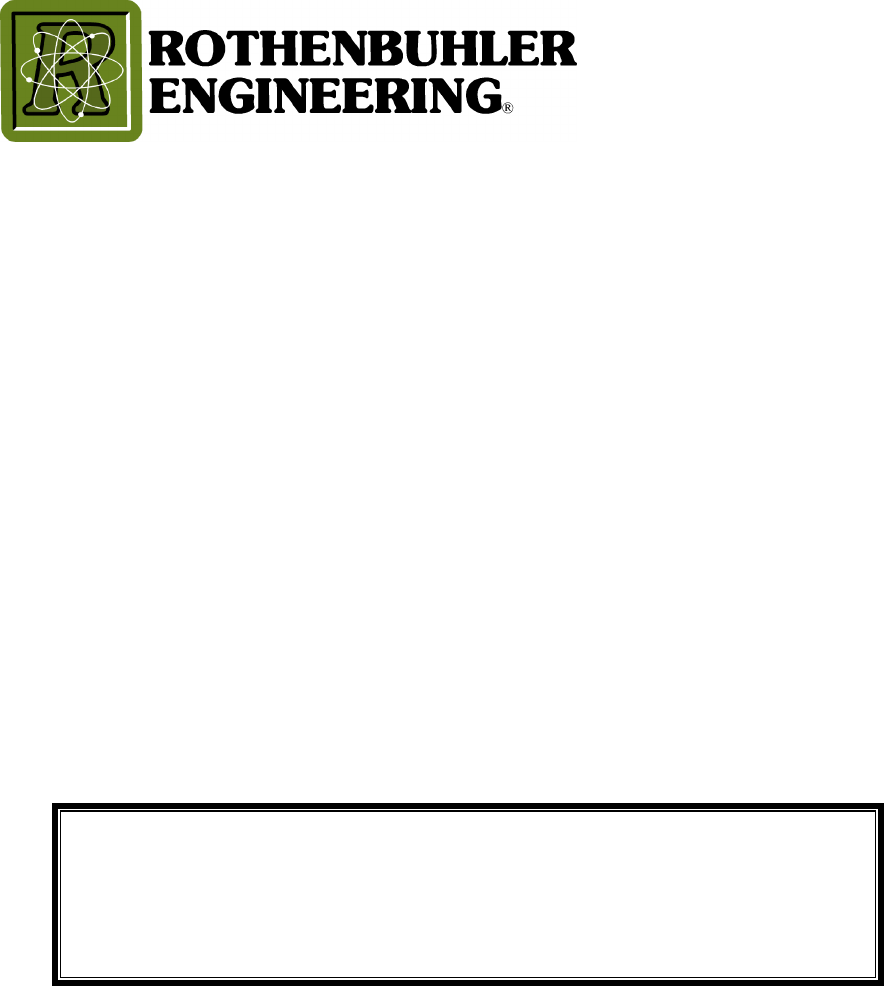
REMOTE FIRING DEVICE
OPERATION MANUAL
The information contained in this document is subject to change
without notice. In no event shall Rothenbuhler Engineering
Company be liable for errors contained herein or for special,
indirect, or consequential damages or injuries of any nature
resulting from use of information in this document.
ROTHENBUHLER ENGINEERING
P.O. BOX 708
524 RHODES ROAD
SEDRO WOOLLEY, WA 98284
1678-A16C
5/20/2013
©2011, 2012, 2013 Rothenbuhler Engineering
All Rights reserved
1678 RFD OPERATION MANUAL ii
SPECIAL NOTICE
WARNING TO USERS AND AFFECTED PERSONS
The Remote Firing Device (RFD) is designed to be used in blasting operations.
Explosives used in connection with the RFD may be extremely powerful. Improper use
of explosives with or without the RFD or improper safety precautions taken with respect
to personnel or property may result in death, serious personal injury, or property
damage. Other manufacturers’ equipment that may not be in compliance with
frequency coordination may inadvertently interfere with the operation of the RFD. Be
aware of other operations within the receiving range of the RFD.
The literature accompanying this warning contains information of a general nature for
users of the RFD based upon the manufacturer’s experience in the design and
manufacture of remote radio frequency devices. In addition, the manufacturer provides
product literature and technical data sheets periodically which should be consulted for
detailed information on the characteristics, specifications and recommendations for the
RFD. The manufacturer does not purport to give information or advice on explosives or
their use.
The RFD and related explosive devices are intended for use only by trained
professionals having comprehensive knowledge of the RFD, the explosives being used,
and the application together with all related safety precautions. The manufacturer of the
RFD is responsible only for the proper performance of the RFD itself and is not
responsible for the performance, safety, or specifications of the explosive used, nor the
suitability of the RFD for any particular purpose other than that expressly described in
the manufacturer’s literature.
LIMITED WARRANTY
The manufacturer warrants the Model 1678 Remote Firing Device (RFD) to be free of
defects in workmanship or materials for the period of one year from the date of
purchase. In the event any RFD or component thereof is shown to be defective in
workmanship or materials within one year, the system or component will be repaired or
replaced without charge by the manufacturer at the manufacturer’s place of business.
This warranty does not cover damage or injury to equipment resulting from abuse,
neglect, or use in applications other than expressly described by the manufacturer as fit
purposes for the RFD.
This Limited Warranty is given in lieu of all other legal warranties express or implied and
neither the manufacturer nor its representatives shall be liable for any direct, incidental
or consequential loss or damages arising out of any occurrence or accident involving
the use of this product.

1678 RFD OPERATION MANUAL iii
FCC NOTICE
This device complies with Part 15 of the FCC regulations. Operation is subject to the
following two conditions: (1) That this device may not cause harmful interference, and
(2) this device must accept any interference received, including interference that may
cause undesired operation.
RADIATION HAZARD WARNING
This radio shall only be used during the course of employment by individuals aware of
the hazards of radio frequency (RF) radiation exposure, and the ways to minimize such
hazards. This radio is not intended for use by the "General Population." Further, this
radio must not be co-located or operated in conjunction with any other antenna or
transmitter. User should not allow antennas to come within 20 cm (8 inches) of the body
during use.
CANADA
**
This Class B digital apparatus meets all requirements of the Canadian Interference-
Causing Equipment Regulations.
Cet appareil numérique de la classe B respecte toutes les exigences du Règlement sur
le matériel brouilleur du Canada.
Under Industry Canada regulations, this radio transmitter may only operate using an
antenna of a type and maximum (or lesser) gain approved for the transmitter by Industry
Canada. To reduce potential radio interference to other users, the antenna type and its
gain should be so chosen that the equivalent isotropically radiated power (e.i.r.p.) is not
more than that necessary for successful communication.
These radio transmitters (IC: 2758A-166921, 2758A-16784, & 2758A-167801V2) have
been approved by Industry Canada to operate with the antenna types listed below with
the maximum permissible gain and required antenna impedance for each antenna type
indicated. Antenna types not included in this list, having a gain greater than the
maximum gain indicated for that type, are strictly prohibited for use with this device.
Antenna: ¼ wave whip, gain 2.15 dBi
1678 RFD OPERATION MANUAL iv
Conformément à la réglementation d'Industrie Canada, le présent émetteur radio peut
fonctionner avec une antenne d'un type et d'un gain maximal (ou inférieur) approuvé
pour l'émetteur par Industrie Canada. Dans le but de réduire les risques de brouillage
radioélectrique à l'intention des autres utilisateurs, il faut choisir le type d'antenne et son
gain de sorte que la puissance isotrope rayonnée équivalente (p.i.r.e.) ne dépasse pas
l'intensité nécessaire à l'établissement d'une communication satisfaisante.
Le présent émetteur radio (IC: 2758A-166921, 2758A-16784, & 2758A-167801V2) a été
approuvé par Industrie Canada pour fonctionner avec les types d'antenne énumérés ci-
dessous et ayant un gain admissible maximal et l'impédance requise pour chaque type
d'antenne. Les types d'antenne non inclus dans cette liste, ou dont le gain est supérieur
au gain maximal indiqué, sont strictement interdits pour l'exploitation de l'émetteur.
Stabantenne: ¼ longueur d'onde, gain 2.15 dBi
1678 RFD OPERATION MANUAL v
TABLE OF CONTENTS
Chapter Page
SPECIAL NOTICE ..........................................................................................................II
WARNING TO USERS AND AFFECTED PERSONS .................................................... II
LIMITED WARRANTY....................................................................................................II
FCC NOTICE .................................................................................................................III
RADIATION HAZARD WARNING.................................................................................III
CANADA........................................................................................................................III
TABLE OF CONTENTS..................................................................................................V
LIST OF ILLUSTRATIONS..........................................................................................VIII
SAFETY INFORMATION...............................................................................................IX
1. INTRODUCTION.................................................................................................. 1
1.1. Purpose............................................................................................................. 1
1.2. Environmental Considerations ..........................................................................1
1.3. Compliance Standards...................................................................................... 2
2. INTRODUCTION TO RFD SYSTEM COMPONENTS ......................................... 3
2.1. System.............................................................................................................. 3
2.2. Controller Unit................................................................................................... 6
2.3. Mini Controller Unit ........................................................................................... 6
2.4. Controller Switch Operation ..............................................................................7
2.5. Controller Display Operation........................................................................... 10
2.6. Electric Remote Unit ....................................................................................... 13
2.7. Remote Shock Tube Initiator (RSTI)............................................................... 16
2.8. 3 Position Battery Charger.............................................................................. 19
1678 RFD OPERATION MANUAL vi
2.9. 5 Position Charger & Conditioner.................................................................... 20
2.10. Test Box ......................................................................................................22
2.11. Antenna Assembly ...................................................................................... 24
2.12. Carrying Case ............................................................................................. 25
2.13. Vent operation............................................................................................. 26
2.14. Antenna / Battery Charger Connector ......................................................... 27
3. SYSTEM SPECIFICATIONS.............................................................................. 28
3.1. Radio .............................................................................................................. 28
3.2. Physical........................................................................................................... 29
3.3. Battery ............................................................................................................ 29
3.4. Timing ............................................................................................................. 30
3.5. Detonate Output.............................................................................................. 30
3.6. System Identification....................................................................................... 31
4. PRE-OPERATIONAL PROCEDURES............................................................... 33
4.1. Physical Inspection ......................................................................................... 33
4.2. Battery Charging............................................................................................. 33
4.3. Battery Charging With the 3 Position Charger ................................................ 34
4.4. 5 Position Charger & Conditioner.................................................................... 36
4.5. 5 Position Charge procedure .......................................................................... 38
4.6. Bench Testing the System ..............................................................................40
5. OPERATIONAL PROCEDURES ....................................................................... 42
5.1. Ready the System at Site ...............................................................................42
5.2. Placement of Remote Units ............................................................................ 43
5.3. System Operation – Remote Units Within 1 Mile of Controller........................ 44
5.4. System Operation – Remote Units More Than 1 Mile but Less than 5 miles
From Controller......................................................................................................... 45
5.5. System Operation – Remote Units Both Within and In Excess of 1 Mile from
Controller .................................................................................................................. 47
1678 RFD OPERATION MANUAL vii
6. POST OPERATIONAL PROCEDURES ............................................................50
6.1. Securing the System....................................................................................... 50
6.2. Physical Inspection ......................................................................................... 50
6.3. Packaging ....................................................................................................... 50
6.4. Maintenance & Equipment Storage ................................................................ 50
7. BASIC TROUBLESHOOTING IN THE FIELD................................................... 51
7.1. Remote Units .................................................................................................. 51
7.2. Controller ........................................................................................................ 51
7.3. Remote Shock Tube Initiator...........................................................................51
8. OPTIMIZING RANGE......................................................................................... 52
9. TEST BOX..........................................................................................................56
9.1. Test Box Operation......................................................................................... 56
9.2. Programmable Parameters............................................................................. 64
9.3. Required equipment........................................................................................ 64
9.4. Windows Configuration Software (RFD HS Terminal Utility)........................... 64
9.5. RFD HS Terminal Utility Installation................................................................ 64
9.6. Installing Test Box USB Cable Drivers............................................................ 66
9.7. Using RFD HS Terminal Utility to Test RFD Units .......................................... 70
10. MAINTENANCE.................................................................................................74
10.1. Scheduled servicing .................................................................................... 74
10.2. Battery Charging Information.......................................................................74
10.3. Battery Pack Replacement.......................................................................... 75
10.4. Extended non-use ....................................................................................... 78
1678 RFD OPERATION MANUAL viii
LIST OF ILLUSTRATIONS
Figure 2-1 RFD 4-Remote Case System......................................................................... 4
Figure 2-2 Controller Unit................................................................................................ 6
Figure 2-3 Mini Controller Unit ........................................................................................ 7
Figure 2-4 Mini Controller Isometric View with Antenna................................................ 12
Figure 2-5 Electric Remote Unit .................................................................................... 13
Figure 2-6 Electric Remote Unit Angled View ............................................................... 15
Figure 2-7 Remote Shock Tube Initiator (RSTI)............................................................ 16
Figure 2-8 RSTI Angled View with Shock Tube Spark Tip ............................................ 17
Figure 2-9 Shock Tube Tip............................................................................................ 18
Figure 2-10 3 Position Charger ..................................................................................... 19
Figure 2-11 5 Position Charger & Conditioner............................................................... 20
Figure 2-12 Test Box..................................................................................................... 22
Figure 2-13 Antenna Assembly..................................................................................... 24
Figure 2-14 Carrying Case............................................................................................ 25
Figure 2-15 Vent Operation........................................................................................... 26
Figure 2-16 3 Position Charger Connection .................................................................. 27
Figure 3-1 Electric Remote and RSTI Unit Front Label ................................................. 31
Figure 4-1 5 Position Charger & Conditioner................................................................. 36
Figure 8-1 Unit Normal Transmission Location ............................................................. 52
Figure 8-2 Remote Unit Elevated.................................................................................. 53
Figure 8-3 Mini Controller Unit Elevated........................................................................54
Figure 8-4 Antenna Radiation Pattern (All Units) .......................................................... 55

1678 RFD OPERATION MANUAL ix
Figure 9-1 Test Box....................................................................................................... 56
SAFETY INFORMATION
The following are WARNINGS and CAUTIONS, contained throughout this manual and
are repeated here for emphasis. All personnel engaged in the handling, firing, and
storage of the system covered in this manual must fully understand these WARNINGS
and CAUTIONS, and procedures by which hazardous conditions are to be reduced or
eliminated. Also listed are general safety precautions that are not related to any specific
procedures and therefore don't appear elsewhere in this publication. These are
recommended precautions that personnel must understand and apply during many
phases of operation and maintenance.
WARNING
Never rely on the equipment for your safety.
WARNING
Use of this system and its components must be restricted to personnel
qualified and experienced in the field of explosives and detonating devices. Under no
circumstances shall untrained personnel attempt to use this manual as a text for self-
teaching.
WARNING
This system and its components should be stored in a secure area with
no access to unauthorized personnel. This system can be used in conjunction with
explosives as a deadly weapon.
WARNING
These radios contain batteries. The potential for activation is always
present whether or not antennas are attached to the units.
WARNING
Employ standard blasting system safety standards when using this
equipment with explosives.
WARNING
Lightning induced energy, caused by electrical storms, can detonate
explosives. In the interest of safety, blasting on land, water and underground should be
suspended and all personnel should be evacuated to a safe distance from the blast
area whenever lightning storms are in the vicinity. Dangerous levels of static electricity
can build up in the atmosphere. These levels can be sufficient to detonate explosives.
WARNING
Radio frequency energy of sufficient magnitude can cause blasting
caps to detonate.
WARNING
To eliminate long wire runs, and to make the "shoot" from a safe
distance, the Remote Firing Device uses low energy level radio frequency
transmissions.

1678 RFD OPERATION MANUAL x
WARNING
Do not connect a blasting cap to a Remote Unit unless the green
SAFE light is on, the red ARMED light is off, and the yellow ON/LOW BATT light is on
steady. This indicates there is no voltage on the binding posts, the binding posts are
electically isolated from the firing capacitor, the binding posts are shunted to each other,
and the battery is not low.
WARNING
Ensure that blasting caps are not connected to any of the Remote
Units during bench testing.
WARNING
This is a sensitive electronic radio system and it may be damaged.
WARNING
Do not use the Controller within 100 feet (30 meters) of explosives,
blasting caps, or wires leading to them. The Controller signal is 5 watts, which can
cause detonation of caps if within 100 feet. The 5 watt Controller complies with the
Recommended Table of Distances established by the Institute for the Makers of
Explosives (IME) when placed beyond 100 feet of explosives.
WARNING
Do not engage in RFD communications with the Remote Units when
they are connected to explosive charges until the shot is prepared and all personnel are
clear. The Remote Unit complies with the Recommended Table of Distances
established by the Institute for the Makers of Explosives (IME) when placed 25 feet (8
meters) or more from blasting caps or wires leading to them. For further information,
refer to the Institute for the Makers of Explosives Publication no. 20, Part II, Section (1).
WARNING
Do not touch the Shock Tube Tip Jacks on the top of the Remote
Shock Tube Initiator (RSTI) when armed or firing. Lethal voltages may be present.
CAUTION Do not assume the DISARM command has been received by the
Remote Unit unless disarmed status is confirmed with a steady SAFE light for that
Remote Unit on the Controller display panel. If distance appears to be the problem,
move closer to the Remote Unit following standard procedures for this type of situation.
The “STATUS” and/or “DISARM” switches may be pressed repeatedly as the Remote
Unit is approached. Maintain a safe distance from the Remote Unit. Do not approach
the Remote Unit until disarmed status is confirmed with a steady SAFE light for that
Remote Unit on the Controller display panel. Under no conditions should the “FIRE”
switch be pressed as the Remote Unit is approached. DO NOT bring the Controller
closer than 100 feet (30 meters) to blasting caps, wires connected to blasting caps, or
other explosives.
CAUTION All units must be thoroughly tested and the batteries fully charged prior
to operational use.
CAUTION Unequal air pressure inside the Controller may affect the operation of
membrane switch keypad. Extreme pressure differentials may irreversibly damage the
keypad and/or cases.
CAUTION Vents in all units should be momentarily opened and closed
immediately before use.
1678 RFD OPERATION MANUAL xi
CAUTION Do not open a vent if there is water on or near the vent. Keep the vents
closed when the relative humidity is above 90%. Take necessary precautions to ensure
moisture does not enter the unit case.
CAUTION Do not use any component that is damaged, suspected of being
damaged, or is not able to operate as designed. The safety of the operation could be
compromised.

1678 RFD OPERATION MANUAL 1
1. INTRODUCTION
1.1. PURPOSE
1.1.1. The primary purpose of this manual is to provide descriptive information,
operational information, instructions in assembly, and instructions in testing and
preparation for operational or training use of the Remote Firing Device (RFD).
1.1.2. The Remote Firing Device (RFD) is used to activate electric and non-electric
detonator devices. The System is strictly an electronic device, containing no
explosive. The Controller or Mini Controller Unit shall be operated from 100 feet (30
meters) to five miles (8 km) from the explosive. The Electric Remote Unit shall be
placed at the explosive site, with a two-conductor firing line running to the explosive.
The Remote Shock Tube Initiator (RSTI) is placed at the explosive site, with non-
electric shock tube running to the explosive. The Controller or Mini Controller Unit
communicates to the Remote Units through a two-way RF transmitter data link, for a
typical distance greater than 5 miles (8 km). The Remote Unit can typically return
communication for a distance greater than 1 mile (1.6 km). Actual communication
range is dependant upon a variety of factors such as terrain, obstacles, antenna
height, and local interference.
1.1.3. Throughout this manual, the term “Controller” is a generic term that is used
whenever applicable for both the Controller Unit and for the Mini Controller Unit.
1.1.4. Throughout this manual, the term “Remote Unit” is a generic term that is
used whenever applicable for both the Electric Remote Unit and for the RSTI.
1.2. ENVIRONMENTAL CONSIDERATIONS
1.2.1. The Controller and Remote Unit have manual operated vents. The vents
should always be CLOSED during air transport, underwater transport, storage and
operational use to prevent moisture intake. The operator should momentarily open
and close the vent after the unit has been subjected to changes in elevation, depth, or
temperature. This equalizes pressure within the case to the outside environment. DO
NOT open the vent if there is water on or near the vent or if the relative humidity is
above 90%. Towel dry vents prior to opening. The vents should be OPEN whenever
the unit is stored in a dry hot environment.
1.2.2. The Controller and Remote Units (with vents closed) are airtight to an
altitude of 30,000 feet (9,000 meters) and watertight to a depth of 100 feet (30
meters).
1.2.3. The Controller and Remote Units are shock resistant, drop tested from 5
feet onto 3 inches of steel plate backed by concrete.

1678 RFD OPERATION MANUAL 2
1.2.4. The battery pack and unit electronics are electrically isolated from the unit
case.
1.2.5. The Controller and Remote Units have a operation temperature range from
-22 ºF to +140 ºF (-30 ºC to +60 ºC).
1.3. COMPLIANCE STANDARDS
• MIL-STD-810F, Method 501.4, Procedure II, High Temperature Test
• MIL-STD-810F, Method 502.4, Procedure II, Low Temperature Test
• MIL-STD-331C, A4.1, 5 feet (1.5 meter) Drop Test
• MIL-STD-331C, Test C7, Thermal Shock
• MIL-STD-331C, B1.6.2.2b, Loose Cargo / Vibration
• MIL-STD-331C, Test C4 modified to 100 feet (30 meters), Water Immersion

1678 RFD OPERATION MANUAL 3
2. INTRODUCTION TO RFD SYSTEM COMPONENTS
2.1. SYSTEM
2.1.1. The RFD is a battery powered, hand held, radio remote controlled system to
be used on land as a primary firing mechanism to detonate explosive charges. The
RFD system consists of a either a Controller Unit or a Mini Controller Unit and up to
either eight Remote Units (Controller Unit) or four Remote Units (Mini Controller). Any
combination of Electric Remotes and RSTIs may be used.
2.1.2. The Controller and Remote Units in one system will not operate with units
from another system.
2.1.3. The system has two modes of operation. The two modes are one-way, and
the two-way mode.
2.1.3.1. Range for one-way mode is greater than 5 miles (8 km) typically.
2.1.3.2. Range for two-way mode is greater than 1 mile (1.5 km) typically.
2.1.4. The RFD System consists of the component parts in Table 2-1 and Figure
2-1.
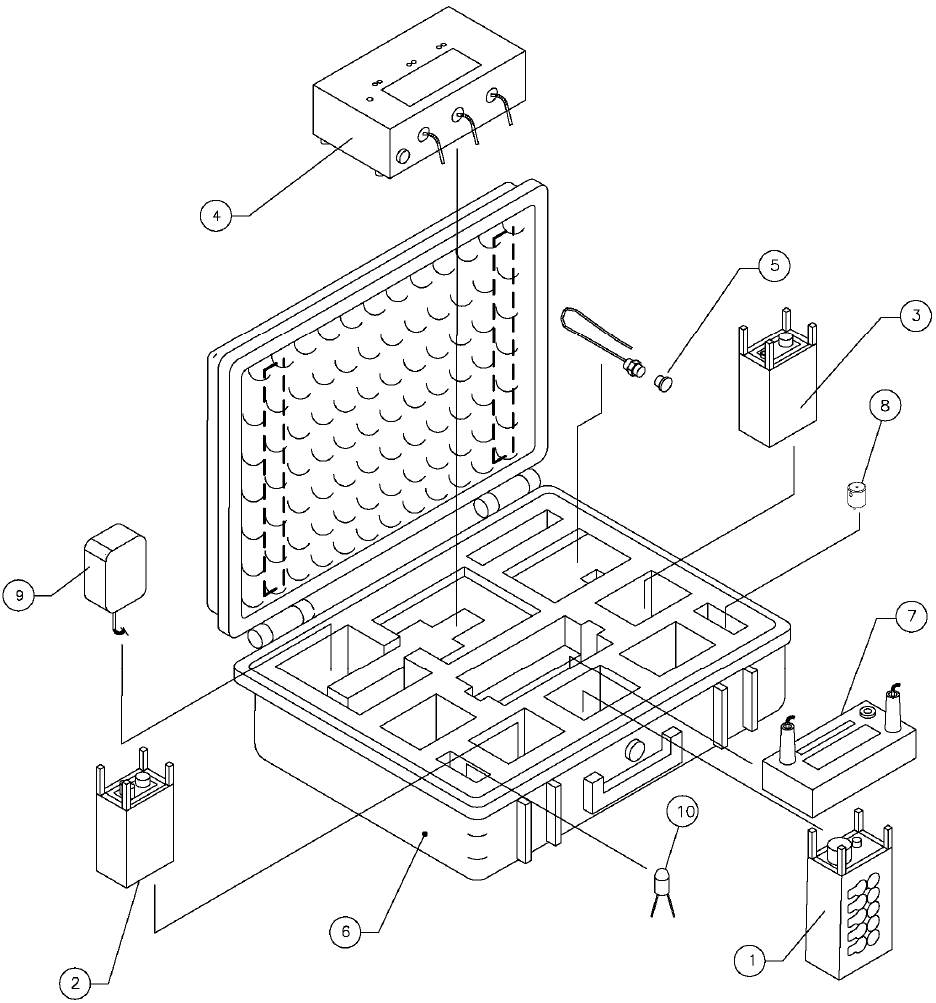
1678 RFD OPERATION MANUAL 4
Figure 2-1 RFD 4-Remote Case System
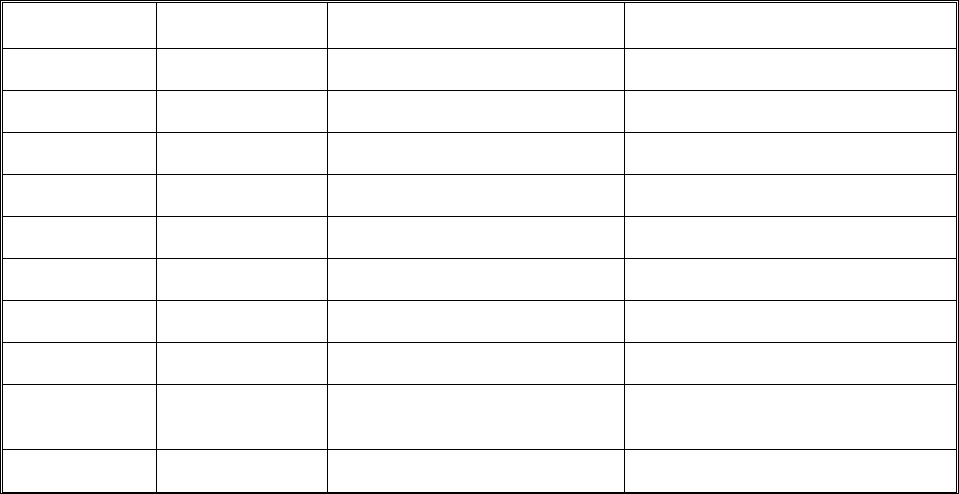
1678 RFD OPERATION MANUAL 5
Table 2-1 RFD 4-Remote Case System
Figure Index No. Description Units per System
Figure 2-1 1 Mini Controller Unit 1*
Figure 2-1 2 Remote Unit, Electric Up to 4 or 8**
Figure 2-1 3 Remote Unit, RSTI Up to 4 or 8**
Figure 2-1 4 Battery Charger See note ***
Figure 2-1 5 Antenna Assembly 1 for each Unit
Figure 2-1 6 Carrying Case Assembly 1
Figure 2-1 7 Test Box See note ****
Figure 2-1 8 Shock Tube Igniter Tip 2 for each RSTI
Figure 2-1 9 Power Supply 1 for each Charger and for each
Test Box
Figure 2-1 10 Test Light 1 for each Electric Remote
* The system is available with either a Controller (up to 8 Remotes) or a Mini Controller
(up to 4 Remotes).
** Any combination of Electric Remotes and Remote Shock Tube Initiators (RSTIs) can
be configured for a maximum total of 8 Remotes for a Controller or 4 Remotes for a Mini
Controller.
*** The system is available with a 3 Position Charger or may come with a 5 Position
Charger & Conditioner.
**** The Test Box is optional.
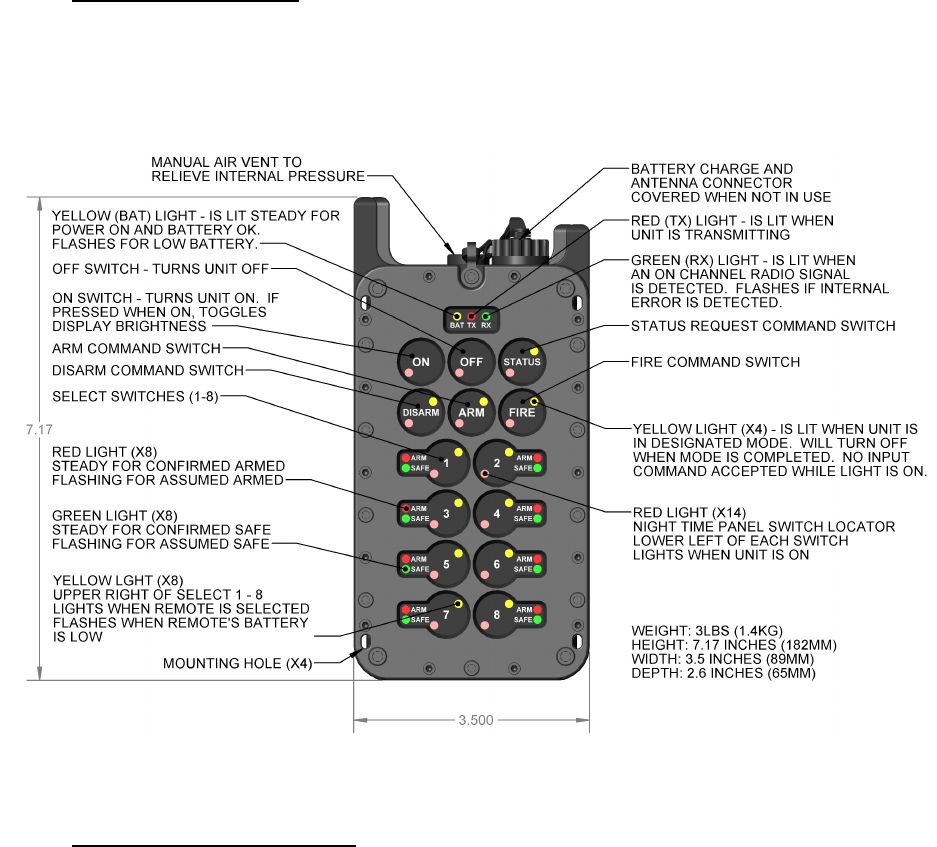
1678 RFD OPERATION MANUAL 6
2.2. CONTROLLER UNIT
2.2.1. Figure 2-2 shows the external features of the Controller Unit. The Controller
is sealed at the manufacturer and should not be opened during field activity. The user
interface features a keypad and intensity adjustable LED display panel.
Figure 2-2 Controller Unit
2.3. MINI CONTROLLER UNIT
2.3.1. Figure 2-3 shows the external features of the Mini Controller Unit. The Mini
Controller is sealed at the manufacturer and should not be opened during field activity.
The user interface features a keypad and intensity adjustable LED display panel.
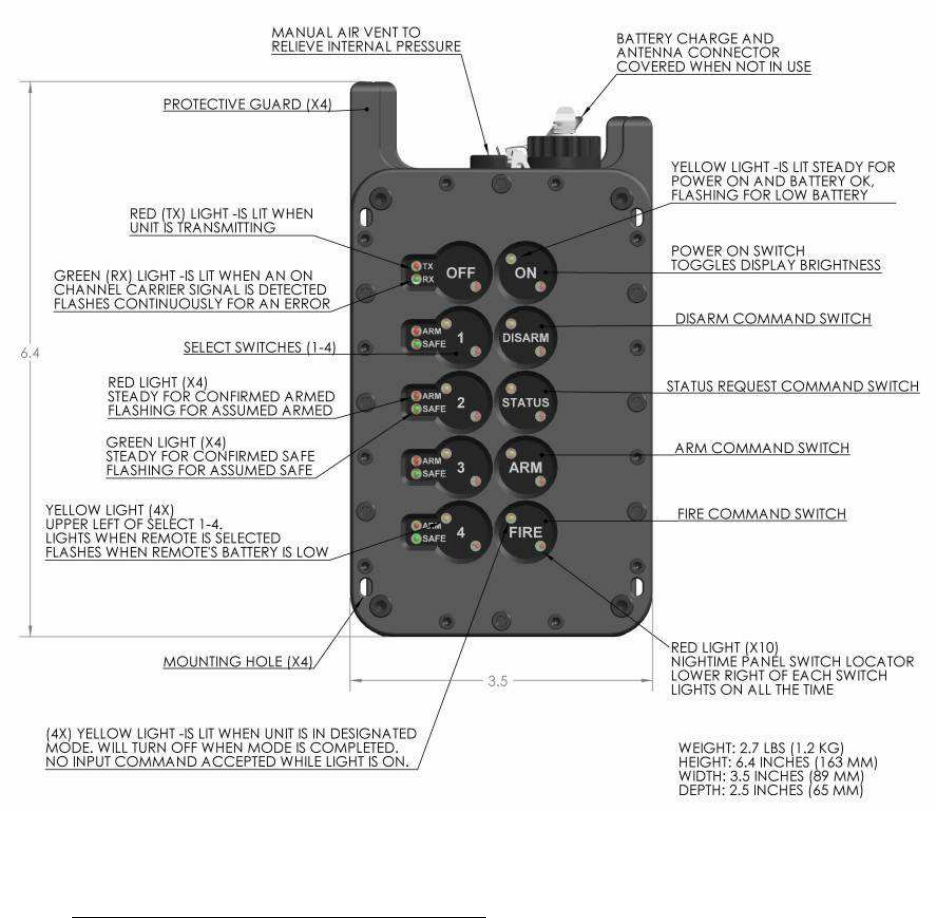
1678 RFD OPERATION MANUAL 7
Figure 2-3 Mini Controller Unit
2.4. CONTROLLER SWITCH OPERATION
2.4.1. The Controller Unit and Mini Controller operate in a very similar manner.
The difference being the maximum number of Remote Units each can control. Unless
otherwise noted, the following descriptions apply to both the Controller Unit and the
Mini Controller.
2.4.2. Unit Power Control: Depress the “ON” switch for one second to turn the
power on to the Controller when the Antenna is attached. The yellow light in the upper
left quadrant of the Mini Controller Unit’s “ON” switch will turn on. The yellow “BAT”
light at the top of the Controller Unit will turn on. Depress the “OFF” switch to turn the
power off to the Controller.
1678 RFD OPERATION MANUAL 8
2.4.3. Power ON Self Test: Upon installing the antenna and pressing the “ON”
switch, a rigorous self test is initiated. If a failure of the self test occurs, the green
receive light (RX) will blink continuously and it will not be possible to operate the unit.
Contact the Manufacturer for service. Do not attempt to use a failing unit.
2.4.4. Display Panel Light Dimmer Circuit: With the unit powered on, Repress
the ‘ON’ switch briefly to toggle the LED display light’s intensity between bright and
dim. When the unit is turned on, the last chosen intensity setting is restored.
2.4.5. Select Remote Units: Depress the Select Switches “1” through “4” or “8” to
select independently the Remote Units that will communicate with the Controller. Any
combination of the four or eight Remote Units may be selected. The yellow SELECT
light on the switch indicates if the Remote Unit programmed for that switch is selected.
Press the switch again and the yellow SELECT light for that Remote Unit will be
turned off indicating the Remote Unit is not selected.
2.4.6. Request Remote Unit Status: Depress the “STATUS” switch to transmit a
status request signal to the selected Remote Units. The selected Remote Units will
transmit their current status to the Controller. If none of the Remote Units are
selected, the Controller will request status from all of the Remote Units. Any
answering Remote Units will be selected automatically. If the Controller is within
range of the Remote Unit transmitter, the status of the selected Remote Unit will be
presented on the display panel with a steady light. If the Controller is out of range of
the Remote Unit transmitter, the status will be assumed from the last command sent to
that Remote Unit. In that case the assumed status of the Remote Unit will flash on the
display panel.
2.4.7. Arm the Remote Unit: Depress the “ARM” switch for 1/2 second and the
Controller will transmit the Arm command to the selected Remote Units. The red
ARMED light at the selected Remote Units will flash on the Controller display panel
until the firing capacitor charging time is completed. The Controller then requests
status of the selected Remote Units. If the Controller is within range of the selected
Remote Unit transmitter, the ARMED red light for that Remote Unit will be on steady
on the Controller display panel. If the Controller is out of range of the selected
Remote Unit transmitter, the red ARMED light for that Remote Unit will continue to
flash on the Controller display panel. If the Fire command is not sent within the Arm
Time Period, the system will disarm automatically.
1678 RFD OPERATION MANUAL 9
2.4.8. Disarm the Remote Unit: Depress the “DISARM” switch. The Controller
will transmit the Disarm command to selected Remote Units. Selected Remote Units
will internally discharge their firing capacitor. Selected Remote Units that receive the
Disarm command will become disarmed within 3 seconds of receiving the command.
The green SAFE light for selected Remote Units will begin to flash on the Controller
display panel. The Controller will then request status of selected Remote Units. If the
Controller is within range of the selected Remote Unit transmitter, the green SAFE
light for that Remote Unit will turn to steady on the Controller display panel. If the
Controller is out of range of the selected Remote Unit transmitter, the green SAFE
light for that Remote Unit will continue to flash on the Controller display panel. The
Fire command must be sent during the Arm Time Period. Once the Arm Time Period
has expired, the Auto Disarm feature will disarm the system automatically.
CAUTION Do not assume the DISARM command has been received by the Remote
Unit unless disarmed status is confirmed with a steady SAFE light for that Remote Unit
on the Controller display panel. If distance appears to be the problem, move closer to
the Remote Unit following standard procedures for this type of situation. The “STATUS”
and/or “DISARM” switches may be pressed repeatedly as the Remote Unit is
approached. Maintain a safe distance from the Remote Unit. Do not approach the
Remote Unit until disarmed status is confirmed with a steady SAFE light for that Remote
Unit on the Controller display panel. Under no conditions should the “FIRE” switch be
pressed as the Remote Unit is approached. DO NOT bring the Controller closer than
100 feet (30 meters) to blasting caps, wires connected to blasting caps, or other
explosives.
2.4.9. Activate the Remote Unit Firing Circuit: Depress the “FIRE” switch for
1/2 second and the Controller will transmit the Fire command to selected Remote
Units. The Controller will only transmit the Fire command to selected Remote Units
whose status is Armed. The selected Remote Units will be placed in Fire Mode and
discharge the firing capacitor across the binding posts. The red ARMED light will turn
off and the green SAFE light for each selected Remote Unit will begin to flash on the
Controller display panel. The Controller will then request status from the selected
Remote Units. If the Controller is within range of the selected Remote Unit transmitter,
the green SAFE light for that Remote Unit will turn to steady on the Controller display
panel. If the Controller is out of range of the selected Remote Unit transmitter, the
green SAFE light for that Remote Unit will continue to flash on the Controller display
panel.
2.4.10. Multistage Firing of Remote Units: Multistage firing provides the ability to
arm all Remote Units at one time, and select any combination of the Remote Units to
fire at different intervals within the Arm Time Period (prior to Auto Disarm). The
procedure for multistage firing is:
• Depress “1” though “4” or “8” switches.

1678 RFD OPERATION MANUAL 10
• Depress “ARM” switch – all Remote Units will arm.
• Depress the switches for the Remote Units that will not be fired initially.
• Depress the “FIRE” switch. Only Remote Units still selected will fire.
• Depress the switches for the Remote Units that were just fired.
• Depress the switches for Remote Units to be fired next.
• Depress the “FIRE” switch. Only Remote Units still selected will fire.
• Repeat as necessary. Remote Units will automatically disarm if not fired within the
Arm Time Period.
2.4.11. Misfires: If a Remote Unit does not fire when the Fire command is sent,
repeat the fire sequence up to 3 times. If the Remote Unit continues not to fire, then a
thirty-minute wait prior to approaching is mandatory. Follow your standard operating
procedures for misfires.
2.5. CONTROLLER DISPLAY OPERATION
2.5.1. Night time Panel Switch Locator: There are 10 or 14 red lights used for
backlighting the Controller switches. When the Controller is powered on, the lights
turn on to help locate the switch positions.
2.5.2. Display Panel Dimmer Circuit: Repressing the ‘ON’ switch toggles the
LED display light’s intensity between bright and dim. When the unit is turned on, the
last chosen intensity setting is restored.
2.5.3. Mini Controller Unit Battery Status: The yellow light at the “ON” switch
displays the Mini Controller Unit BATTERY status. If the Mini Controller Unit battery is
low, the yellow light at the “ON” switch will flash. Otherwise this light will be on steady.
2.5.4. Controller Unit Battery Status: The yellow “BAT” light at the top of the
Controller display panel displays the Controller Unit BATTERY status. If the Controller
Unit battery is low, the yellow light “BAT” will flash. Otherwise this light will be on
steady.
2.5.5. Remote Unit Battery Status: The yellow select light at each of the “1”
through “4” or “8” switches will indicate the selected Remote Units’ battery status after
a status request command is issued. If the selected Remote Unit transmitter is within
range of the Controller and Remote Unit's battery is low, the yellow select light for that
Remote Unit will flash. Else, the select light will be on steady.
1678 RFD OPERATION MANUAL 11
2.5.6. Remote Unit Safe: A green light next to each of the “1” though “4” or “8”
switches is used to indicate when the corresponding Remote Unit is safe/disarmed.
The light will be on steady when the Remote Unit transmitter is within range of the
Controller and it is disarmed. If the Remote Unit transmitter is out of range of the
Controller, the light will flash after a Disarm command has been sent.
2.5.7. Remote Unit Armed: A red light next to each of the “1” though “4” or “8”
switches is used to indicate when the corresponding Remote Unit is armed. The
ARMED light for selected Remote Units will flash after the Arm command is sent to the
selected Remote Units. The ARMED light will go to steady after the firing capacitor
charge time if the Controller is within range of the selected Remote Unit's transmitter.
If the Remote Unit transmitter is out of range of the Controller, the ARMED light will
continue to flash.
2.5.8. Status: A yellow light at the “STATUS” switch lights when the “STATUS”
switch is pressed. The light remains on until the display panel has been updated with
results of the status request. All new commands are blocked while this light is on.
2.5.9. Arm: A yellow light at the “ARM” switch lights when the “ARM” switch is
pressed. This light will stay on for the firing capacitor charge time.
2.5.10. Disarm: A yellow light at the “DISARM” switch lights when the “DISARM”
switch is pressed. This light will stay on until the display panel is updated for the
Disarm command. Other commands will not be sent until this light is turned off.
2.5.11. Fire: A yellow light at the “FIRE” switch lights when the “FIRE” switch is
pressed. This light will stay on until the display panel is updated for the Fire
command. Other commands will not be sent until this light is turned off.
2.5.12. “TX” (Transmit): A red light at the “TX” position lights while Controller is
transmitting. Switch presses (DISARM, STATUS, ARM, FIRE, and 1- 4 or 8) are not
recognized while the Controller is transmitting.
2.5.13. “RX” (Receive): During operation the green “RX” light turns on while
receiving a status response from a Remote Unit. The RX light will also turn on in the
presence of another on channel radio signal or from background radio noise. Blinking
continuously indicates a self-test failure has occurred.
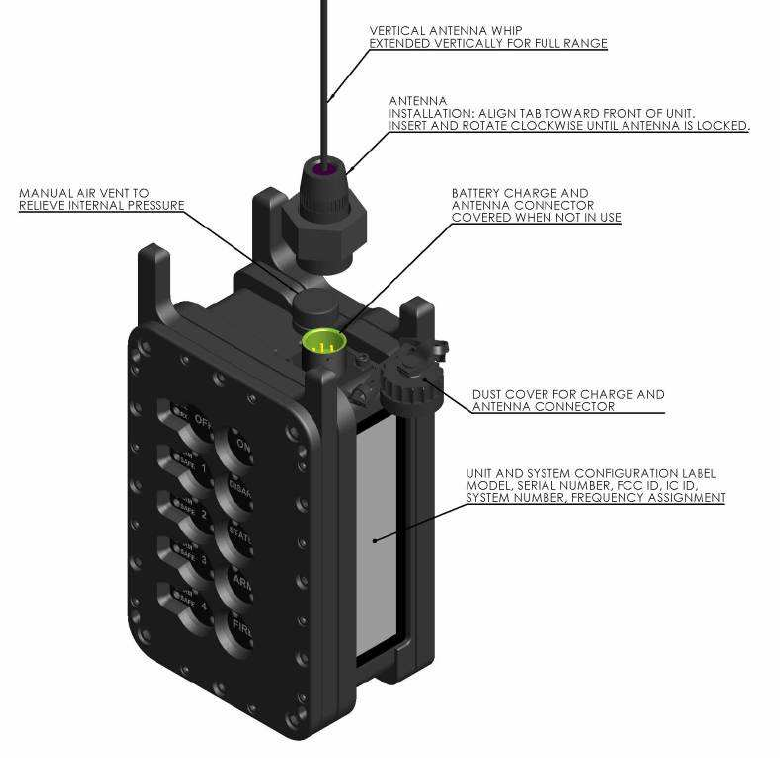
1678 RFD OPERATION MANUAL 12
Figure 2-4 Mini Controller Isometric View with Antenna
2.5.14. Figure 2-4 shows an isometric view to further illustrate the exterior features
of the Mini Controller.
2.5.15. Manual Air Vent: A manual vent is located on top of the unit. The vent is
used to relieve any internal pressure that has accumulated within the unit as a result
of temperature or altitude. The vent is opened when charging to release any gasses or
pressures accumulated during charging. The vent is closed during normal use or when
the unit is exposed to moisture.
2.5.16. Battery Compartment: In the back of the unit is a compartment which
stores the rechargeable battery pack. The battery compartment is isolated from the
unit’s electronics.
2.5.17. System Configuration Label: The System Configuration Label contains
information related to the settings of the unit within the system it operates. The
information displayed on this label may be considered semi-permanent.
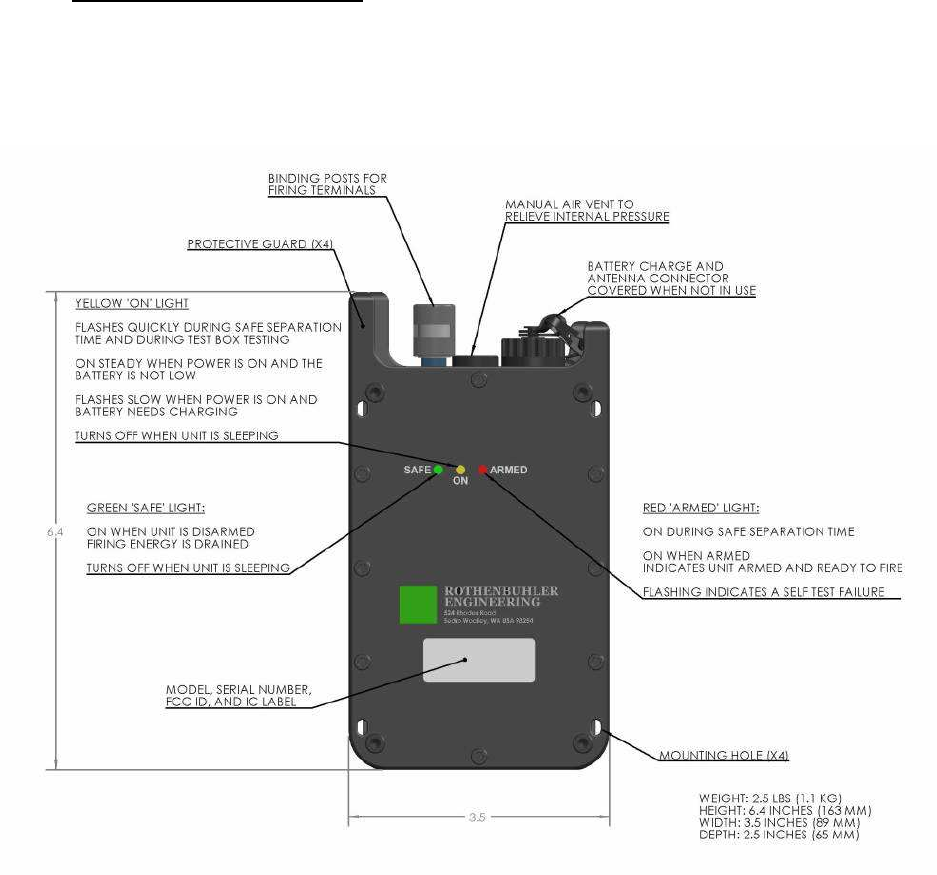
1678 RFD OPERATION MANUAL 13
2.6. ELECTRIC REMOTE UNIT
2.6.1. Figure 2-5 shows the external features of the Electric Remote Unit. The unit
is sealed at the manufacturer or service depot and should not be opened during field
activity.
Figure 2-5 Electric Remote Unit
2.6.2. Power ON Self Test: Immediately after the Electric Remote is turned on by
installing the Antenna, a rigorous self-test is performed. If a failure is detected, the red
ARMED light will blink continuously and all other lights will be extinguished. It is not
possible to use the unit once an error has been detected. The unit must be returned to
the Manufacturer for service. Do not attempt to use a failing unit.
1678 RFD OPERATION MANUAL 14
2.6.3. Safe Separation Time: Upon the installation of the Antenna, a safe
separation countdown timer is initiated. During the safe separation time, the SAFE and
ARMED lights will be on steady, while the ON light blinks rapidly. During the safe
separation time, the unit will not accept any radio commands (i.e. Status, Arm, Disarm,
or Fire). This is to provide a short but highly safe window of time for the user to exit the
immediate vicinity of the blast area. After the safe separation time is complete, the unit
may still be considered safe as long as it does not receive an Arm or a Fire radio
command from the system’s mated Controller. Thus, it is recommended that the
mated Controller be rendered unusable while personnel are within the hazard area.
This can be accomplished by the removal of the Controller’s antenna and its secure
storage until ready for use. The default Safe Separation Time is 15 seconds.
2.6.4. Green SAFE Light: After the Safe Separation Time is complete, the green
SAFE light turns on to indicate that the unit is disarmed; the internal firing capacitor is
fully discharged, and that the unit is operating correctly. The SAFE light will be
extinguished when the unit has entered Sleep Mode (See 2.6.7).
2.6.5. Yellow ON Light: After the unit is activated and has completed its Safe
Separation Time, the yellow ON light will remain illuminated. The ON light will blink
slowly to indicate that its battery needs to be recharged before use. The ON light will
be extinguished when the unit has entered Sleep Mode (See 2.6.7).
2.6.6. Red ARMED Light: After the Safe Separation Time is complete, the red
ARMED light indicates that the unit is armed; the capacitor is charged and the unit is
ready to fire. Appropriate caution of the unit should be observed when the unit is
armed.
2.6.7. Sleep Mode: When enabled, the Electric Remote Unit operates in a sleep
mode to extend the battery’s run time during periods of inactivity. To enter sleep
mode, the unit must be disarmed (safe and capacitor discharged) and the battery must
not be low. Approximately one minute after activity (power on or a radio command),
the unit will enter sleep mode. In sleep mode, the display lights extinguish and all non-
essential functions are suspended. Sleep mode can be exited by sending the unit a
radio command from its mated Controller. Upon receipt of a radio command, the unit
will be immediately awakened and ready for operation. While in sleep mode, units may
run for 200+ hours. Actual sleep mode run time is affected by a variety of factors such
as the sleep mode setting of your system, the state of charge of the battery, the health
of the battery, and the ambient temperatures the unit will be exposed to.
2.6.8. Figure 2-6 provides an angled view of the Electric Remote to show the
System Configuration Label as well as the Battery Compartment Lid. Also illustrated
are various hardware items such as the Binding Posts, Manual Air Vent, and the
labels.
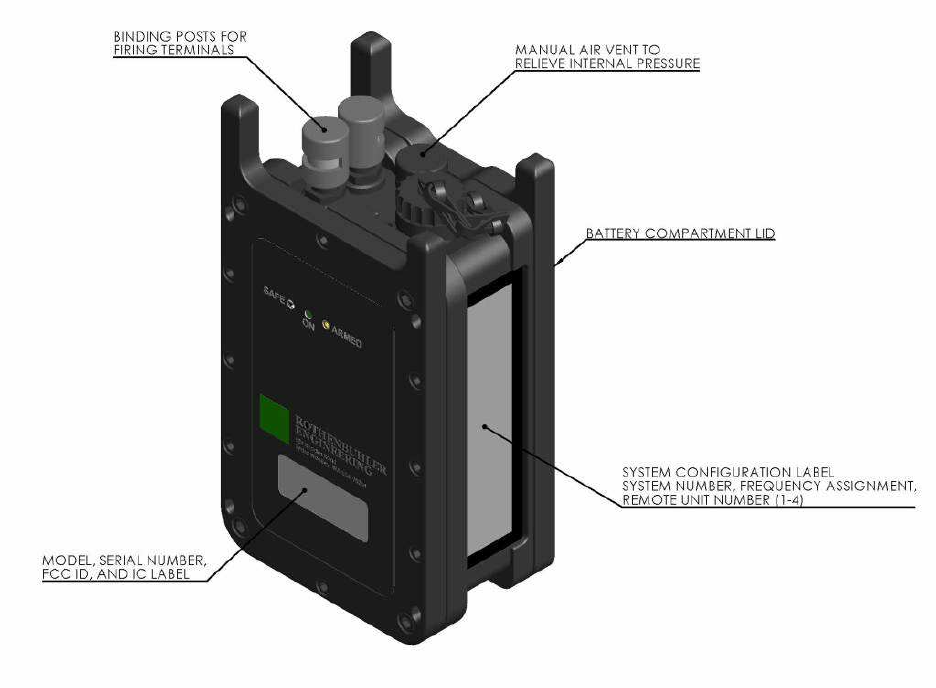
1678 RFD OPERATION MANUAL 15
Figure 2-6 Electric Remote Unit Angled View
2.6.9. Binding Posts: The Binding Posts located on top of the Electric Remote
Unit allow the firing cable to attach to the firing terminals. The insulation at the ends of
the firing cable must be removed prior to attachment. One at a time, depress the top of
the binding posts and insert a leg of the firing cable. Release the binding post, causing
it to grab the lead.
2.6.10. Manual Air Vent: A manual vent is located on top of the unit. The vent is
used to relieve any internal pressure that has accumulated within the unit as a result
of temperature or altitude. The vent is opened when charging to release any gasses or
pressures accumulated during charging. The vent is closed during normal use,
transport, or when the unit is exposed to moisture.
2.6.11. Battery Compartment: In the back of the unit is a compartment which
stores the rechargeable battery pack. The battery compartment is isolated from the
unit’s electronics.
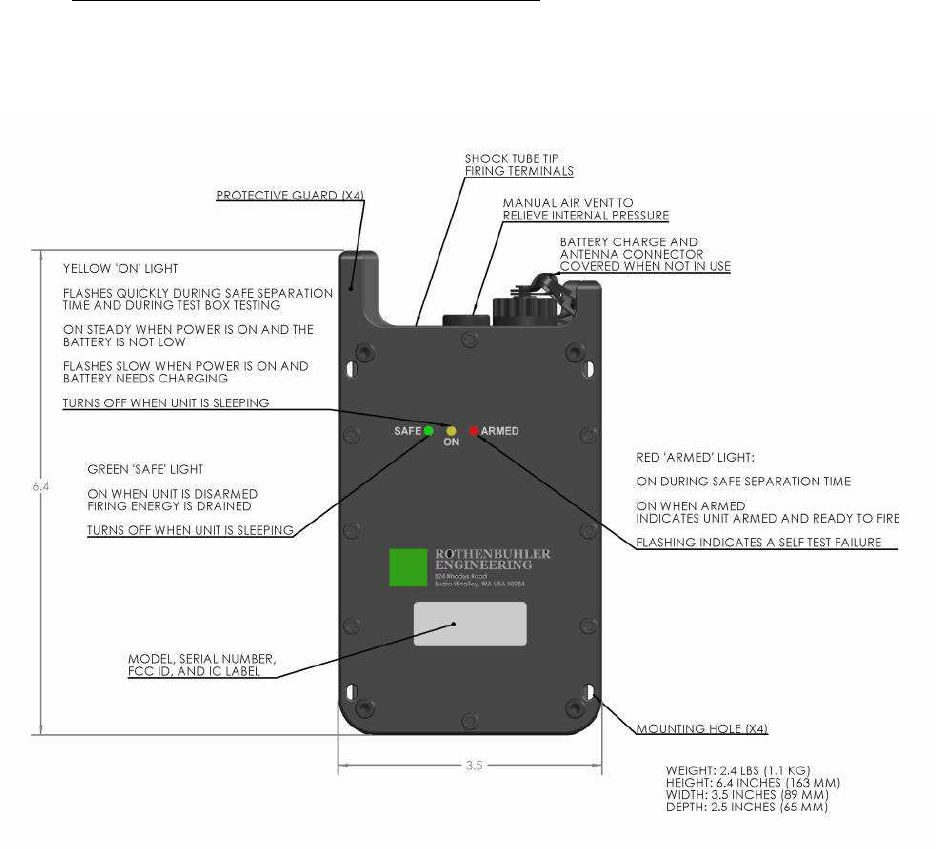
1678 RFD OPERATION MANUAL 16
2.6.12. System Configuration Label: The System Configuration Label contains
information related to the settings of the unit within the system it operates. The
information displayed on this label may be considered semi-permanent.
2.6.13. Model, Serial Number, FCC ID, and IC Label: The information displayed in
this label is permanently assigned by the factory.
2.7. REMOTE SHOCK TUBE INITIATOR (RSTI)
2.7.1. Figure 2-7 shows the external features of the RSTI. The unit is sealed at
the manufacturer or service depot and should not be opened during field activity.
Figure 2-7 Remote Shock Tube Initiator (RSTI)
2.7.2. The RSTI operates similar to the Electric Remote Unit as described in
Section 2.6, but initiates non-electric tubing instead of electric detonators. The RSTI
develops 2,500V at the Shock Tube Tip Firing Terminals when firing.
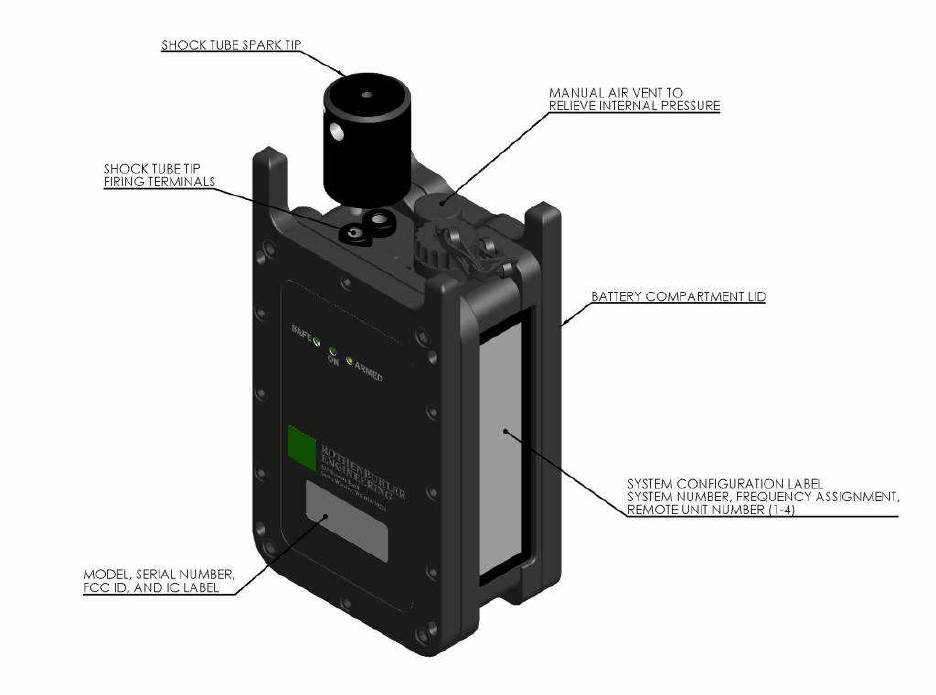
1678 RFD OPERATION MANUAL 17
Figure 2-8 RSTI Angled View with Shock Tube Spark Tip
2.7.3. Figure 2-8 shows the installation of the Shock Tube Firing Tip onto the
Firing Terminals on the RSTI.
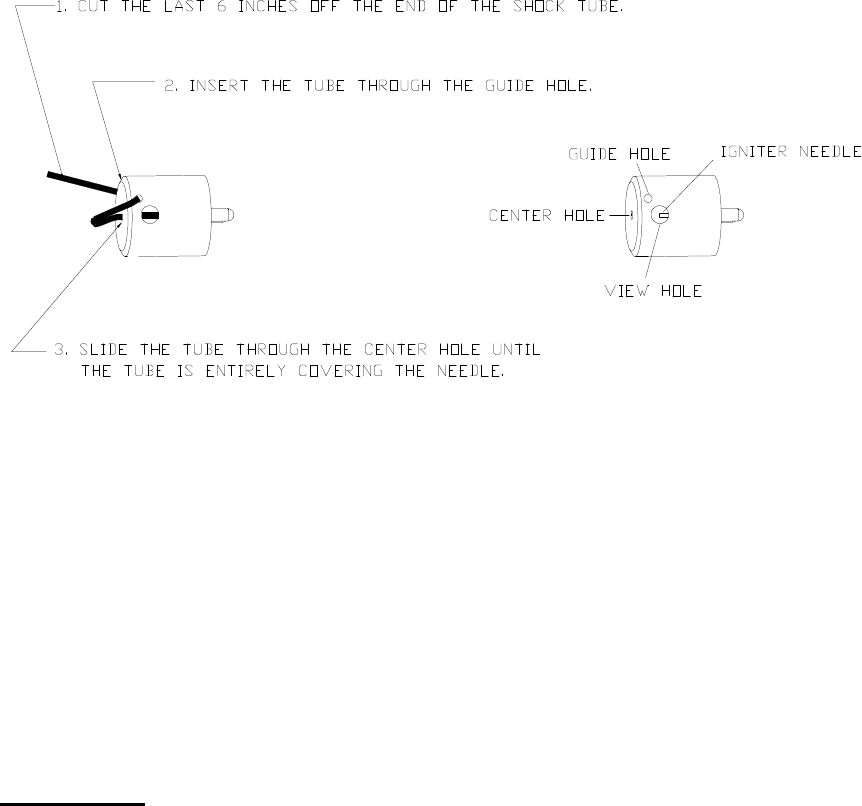
1678 RFD OPERATION MANUAL 18
Figure 2-9 Shock Tube Tip
2.7.4. Figure 2-9 shows the installation of the shock tube onto the shock tube firing
tip when preparing for use. Care should be taken when handling the shock tube to
prevent the incursion of debris or moisture into the tube.
• Keep open tube ends capped during storage and transportation.
• Keep the tip needle clean and dry.
• Replace the tip every 200 shots or if misfiring occurs.
WARNING
Do not touch the Shock Tube Tip Firing Terminals on the Remote
Shock Tube Initiator (RSTI) when armed or firing. Lethal voltages may be present.
1. Make a fresh cut with a sharp knife removing the last 6 inches of shock tube.
2. Insert the shock tube through the guide hole on the tip as shown in Figure 2-9.
The guide hole secures the tube to the tip and prevents pulling out.
3. Insert the tube into the center hole on the flat side. Feed the tube through the
hole observing the side view hole. The tube should slide onto the igniter needle
until the needle is no longer visible and the tube is resting against the plastic tip
housing.
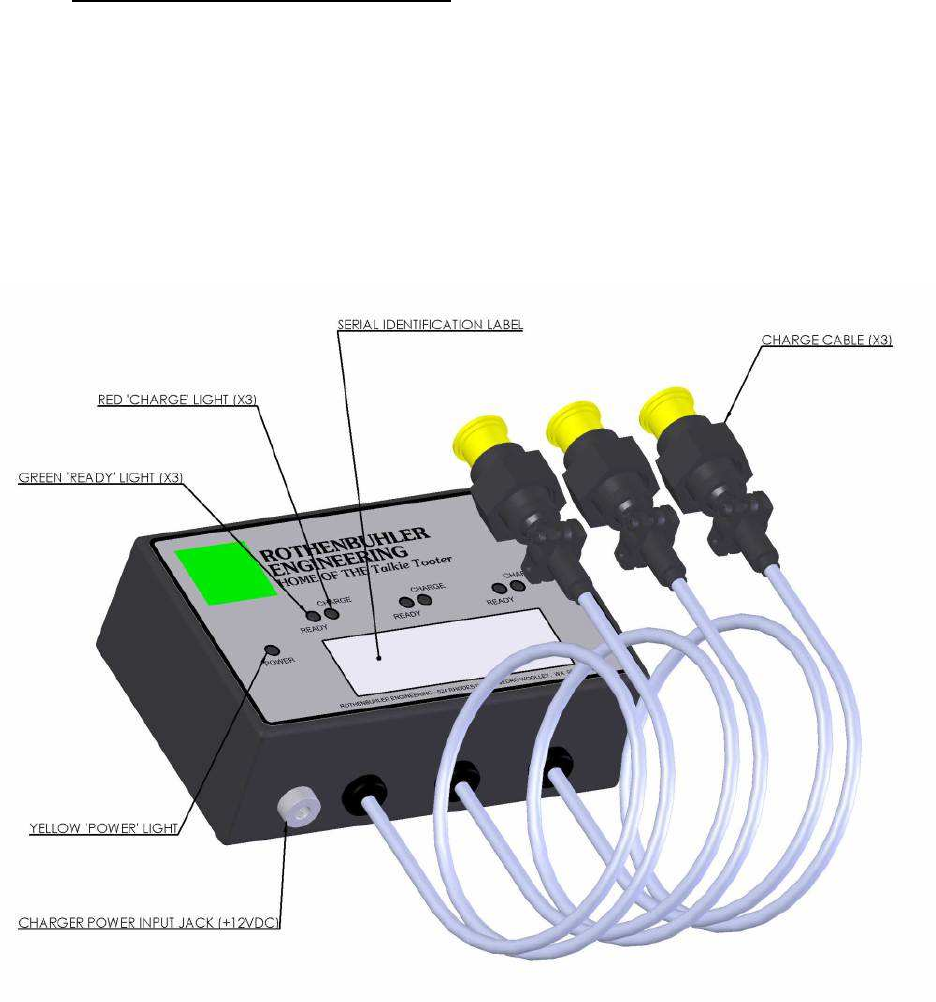
1678 RFD OPERATION MANUAL 19
2.8. 3 POSITION BATTERY CHARGER
2.8.1. Figure 2-10 shows the 3 Position Charger that is configured with some 1678
RFD systems. The 3 Position Charger is a basic NiMH charger which provides a 3 to
4 hour recharge for up to three RFD units (e.g. one Mini Controller and two Remotes).
It may be stored and used within the 1678 case/foam, or it can be stored and used as
a stand-alone device. The 3 Position Charger comes with an AC adapter that can be
configured for use internationally. The 3 Position Charges does not provide discharge
or battery conditioning functions; these features are only available with the 5 Position
Charger & Conditioner. The 3 Position Charger should be stored in a clean, dry place.
Figure 2-10 3 Position Charger
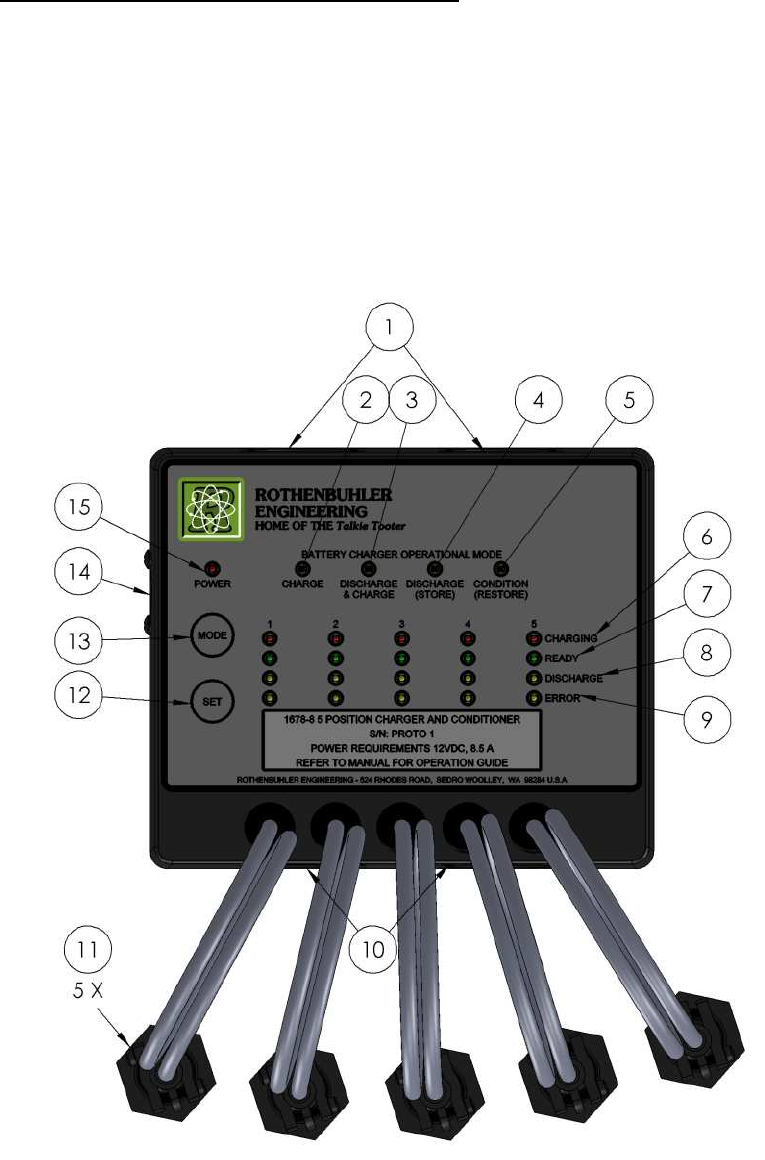
1678 RFD OPERATION MANUAL 20
2.9. 5 POSITION CHARGER & CONDITIONER
2.9.1. Figure 2-10 shows the 5 Position Charger & Conditioner that is configured
with some 1678 RFD systems. The 5 Position Charger & Conditioner charges 5 units
of the 1678 RFD system in about 2 hours. The 5 Position Charger & Conditioner has
advanced features that maximize the health and performance of the battery packs. It
may be stored and used within the 1678 case/foam, or it can be stored and used as a
stand-alone device. The 5 Position Charger & Conditioner comes with an AC adapter
that can be configured for use internationally. The 5 Position Charger & Conditioner
should be stored in a clean, dry place.
Figure 2-11 5 Position Charger & Conditioner
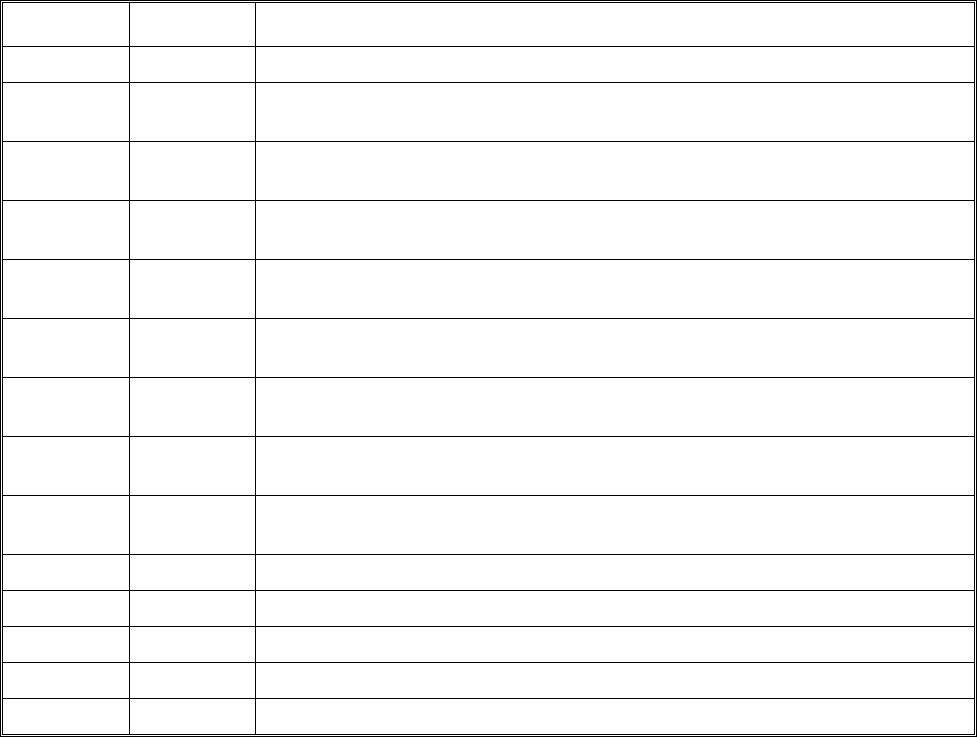
1678 RFD OPERATION MANUAL 21
Table 2-2 RFD 5 Position Charger & Conditioner
Figure Index No. Description
Figure 2-11 1 Cooling air inlets (x2).
Figure 2-11 2 System Charge Mode Indicator (yellow). Indicates the attached units will be
charged only (no discharge).
Figure 2-11 3 System Discharge then Charge Mode Indicator (yellow). Indicates the attached
units will receive a discharge, and then a charge.
Figure 2-11 4 System Discharge Mode Indicator (yellow). This mode is used to discharge the
batteries in preparation for storage.
Figure 2-11 5 System Condition Mode Indicator (yellow). This mode is used to restore
batteries that have been in storage.
Figure 2-11 6 Unit Charge Indicator (red, x5). This indicator lights when the attached unit is
charging.
Figure 2-11 7 Unit Ready Indicator (green, x5). This indicator lights when the attached unit
has completed its charge cycle.
Figure 2-11 8 Unit Discharge Indicator (yellow, x5). This indicator lights when the attached
unit is discharging.
Figure 2-11 9 Unit Error Indicator (yellow, x5). This indicator lights when the attached unit
has experienced a fault when charging.
Figure 2-11 10 Cooling air outlets (x2).
Figure 2-11 11 Charge cables (x5).
Figure 2-11 12 Set Switch, used to set the charger to operate in the selected Mode.
Figure 2-11 13 Mode Switch, used to select the mode of operation for the charger.
Figure 2-11 14 Power Jack, +12V DC.
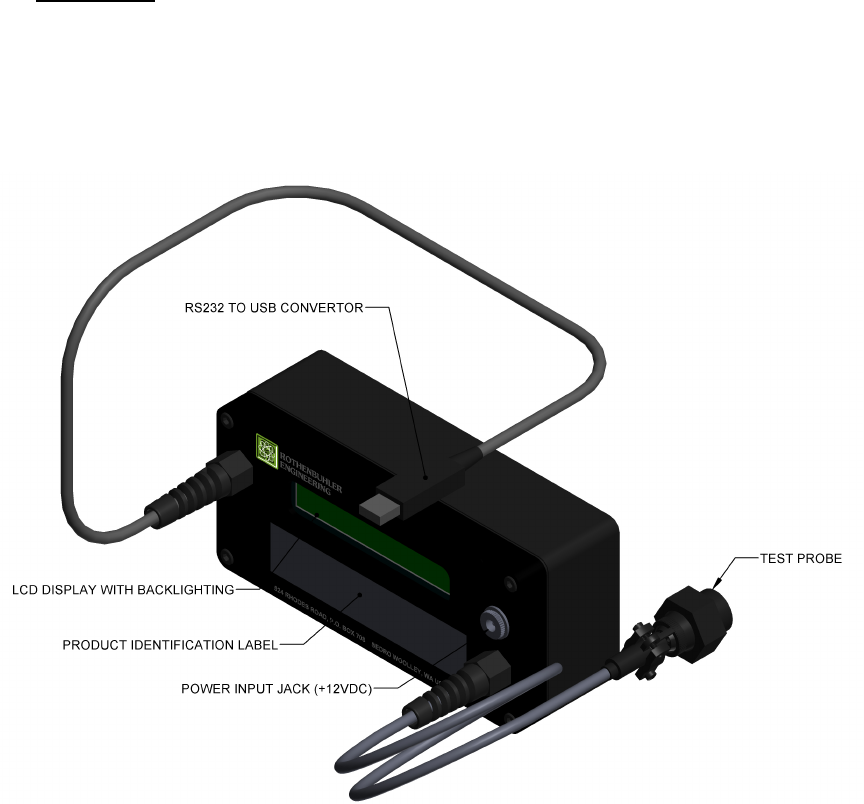
1678 RFD OPERATION MANUAL 22
2.10. TEST BOX
2.10.1. Figure 2-12 provides a drawing of the Test Box. The Test Box is used to
display information from and to evaluate the performance of the Controller, Mini
Controller, Electric Remote Units and RSTIs. The Test Box can also be used to
change settings and parameters of the units with certain restrictions.
Figure 2-12 Test Box
2.10.2. Serial Communications Port: The Test Box can be connected to a USB
port on a host PC. The connection can be used to log the results of the tests
performed. The serial communications port is also used when performing parameter
changes.
2.10.3. Test Probe: The Test Probe connects to the antenna/charge connector on
the top of the Controller, Mini Controller, Electric Remote, or RSTI. Through the Test
Probe, the Test Box communicates with the test unit to read the various settings,
parameters, and to measure firing circuit and loaded battery voltages.
1678 RFD OPERATION MANUAL 23
2.10.4. LCD Display: The LCD displays information both from the Test Box itself
during its power on sequence, and while reading and testing a Controller, Mini
Controller, Electric Remote, or RSTI. The LCD’s backlighting will turn on while the unit
is active. The information that may be displayed on the LCD is listed below:
• Serial Number
• Date of Manufacture
• System Number
• Unit ID
• Frequency Assignments
• Firmware Checksum and Version
• Battery Temperature and Charge Cycle Count
• Fire Count
• Battery voltage of unit under test while the battery is being loaded down.
• Electric Remote Units and RSTIs under test are armed and fired. The firing
voltages are displayed.
2.10.5. Power Input Jack: The Test Box is powered from +12VDC from an AC
adapter. The AC adapter is capable of international use.
2.10.6. Serial Identification Label: This label provides information such as the
Model Number, Serial Number, System Number, Assigned Frequency, and
certification numbers.
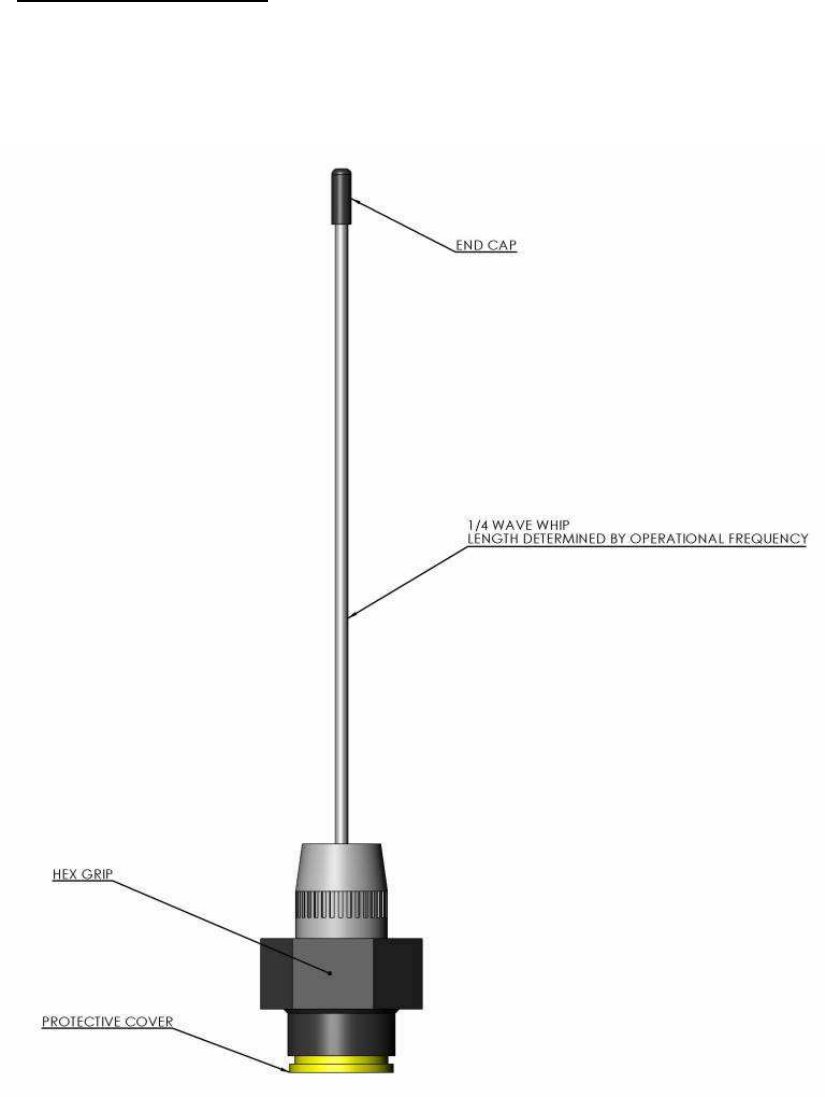
1678 RFD OPERATION MANUAL 24
2.11. ANTENNA ASSEMBLY
2.11.1. Figure 2-13 provides the physical size, technical requirements and view of
the Antenna Assembly. The power to the Controller and Remote Unit is interrupted
when the Antenna Assembly is not connected.
Figure 2-13 Antenna Assembly
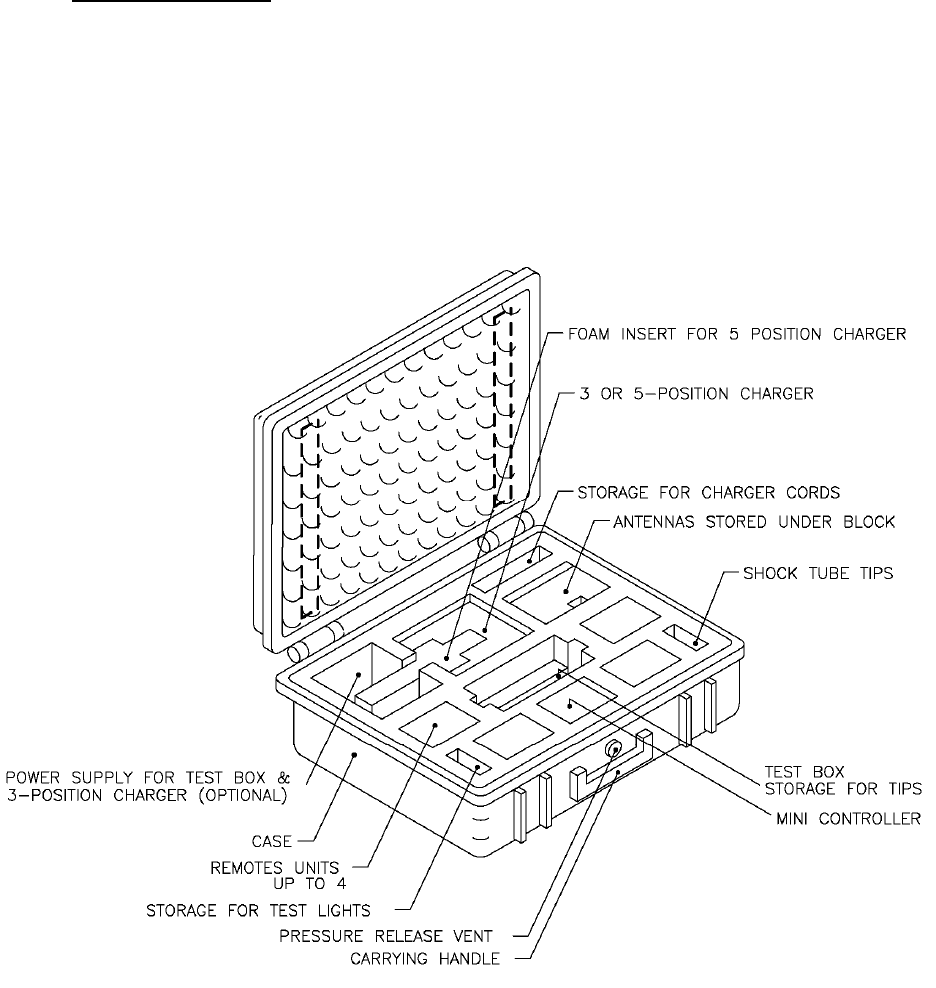
1678 RFD OPERATION MANUAL 25
2.12. CARRYING CASE
2.12.1. Figure 2-14 shows the Carrying Case, providing a view of the storage
location for each system subassembly. The Carrying Case has a pressure
equalization vent near the handle. The vent operation is automatic. There are foam
inserts for the Battery Charger, depending on which model of charger the system is
equipped.
Figure 2-14 Carrying Case
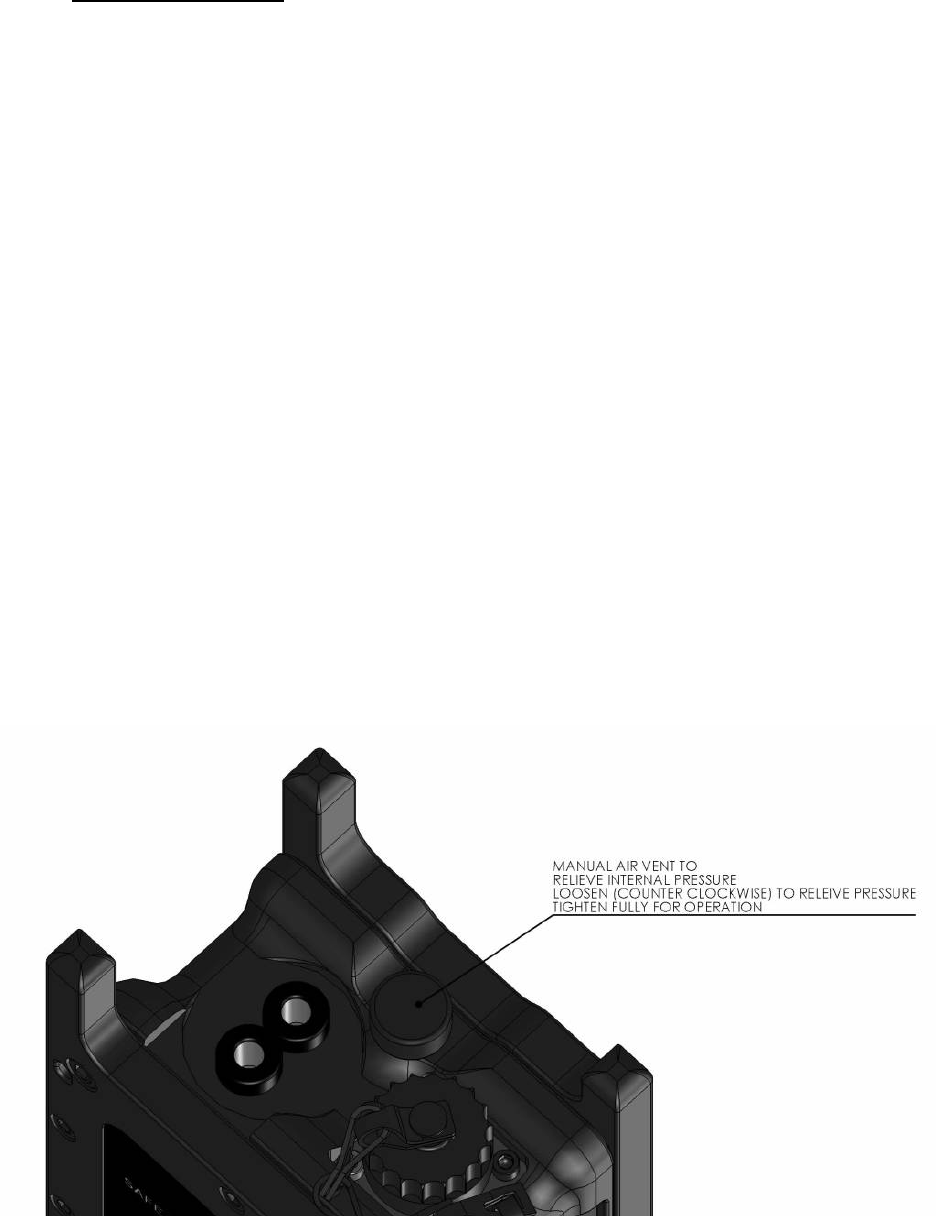
1678 RFD OPERATION MANUAL 26
2.13. VENT OPERATION
2.13.1. In Figure 2-15, the unit vents shown are manually operated and relieve
internal pressure due to heat and altitude. When the vent is closed, it will not leak in
100 feet of water (30 meters) or up to 30,000 feet (9,100 meters) in altitude.
2.13.2. The vent is opened when charging to release any gasses or pressures
accumulated during charging. The vent is closed during normal use or when the unit is
exposed to moisture.
2.13.3. The vent is momentarily opened before use to equalize the case pressure.
2.13.4. To open vent, loosen the knob approximately one turn in the counter-
clockwise direction. To close the vent, turn fully clockwise.
CAUTION Unequal air pressure inside the Controller may affect the operation of
membrane switch keypad. Extreme pressure differentials may irreversibly damage the
keypad and/or cases.
CAUTION Vents in all units should be momentarily opened and closed immediately
before use.
CAUTION Do not open a vent if there is water on or near the vent. Keep the vents
closed when the relative humidity is above 90%. Take necessary precautions to ensure
moisture does not enter the unit case.
Figure 2-15 Vent Operation
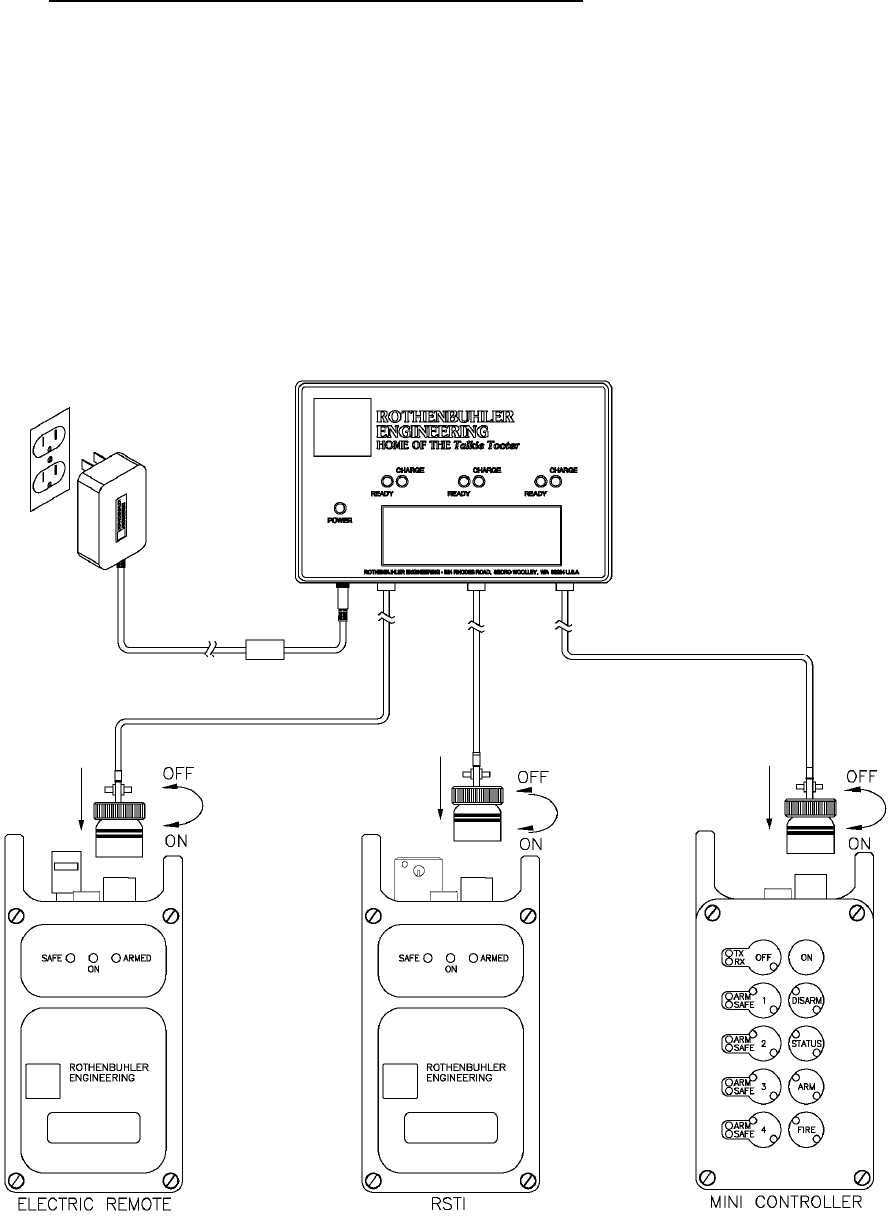
1678 RFD OPERATION MANUAL 27
2.14. ANTENNA / BATTERY CHARGER CONNECTOR
2.14.1. Figure 2-16 shows the connections when using the 3 Position Charger. The
connections for the 5 Position Charger are similar.
2.14.2. The chargers do not discriminate between Controller and Remote units; any
unit may be connected to any charge connector.
2.14.3. There is a key on the charge connector that must be aligned with a slot on
the unit’s charge connector. Align the key and insert. Turn clockwise until the
connector locks into place.
Figure 2-16 3 Position Charger Connection

1678 RFD OPERATION MANUAL 28
3. SYSTEM SPECIFICATIONS
3.1. RADIO
CARRIER
FREQUENCY 150 - 174 MHz OPERATING
TEMPERATURE
RANGE
-30ºC to 60ºC
-22ºF to 140ºF
-26ºC to 60ºC (RSTI)
-15ºF to 140ºF (RSTI)
FCC Certified <freq. diff. 800 HZ (±400)
CONTROLLER & TEST
BOX ELECTRIC
REMOTE & RSTI
FREQUENCY
STABILITY ±2.5PPM OR
(0.0000025%) FREQUENCY
STABILITY ±2.5PPM OR
(0.0000025%)
MODULATION 11K2F3D (AFSK) MODULATION 11K2F3D (AFSK)
MAXIMUM
TRANSMIT
POWER
5 Watts (Controller
and Mini
Controller)
3/4 Watt (Test
Box)
MAXIMUM
TRANSMIT
POWER
2 Watts (Electric
Remote)
5 Watts (RSTI)
OPERATING
POWER 7.2 VDC OPERATING
POWER 7.2 VDC
TRANSMISSION
RANGE (LOS) 5-12 Miles*
3 feet (Test Box)
TRANSMISSION
RANGE (LOS) 1-12 miles*
RECEIVER
SENSITIVITY 12 dB Sinad at
0.28uV RECEIVER
SENSITIVITY 12 dB Sinad at
0.28uV
(*) Range is specified as line-of sight. The typical transmission range is based on
transmitter power, antenna gain, frequency used, local geography, and local radio
interference.

1678 RFD OPERATION MANUAL 29
3.2. PHYSICAL
Mini Controller Unit
Controller Unit
Electric Remote
Unit and RSTI
SIZE (w/out
antenna) (in) 6.4H x 3.5W x 2.6D
7.2H x 3.5W x 2.6D SIZE (w/out
antenna) (in) 6.4H x 3.5W x 2.4D
SIZE (w/out
antenna) (cm) 16.3H x 8.9W x 6.6D
18.3H x 8.9W x 6.6D SIZE (w/out
antenna)(cm) 16.3H x 8.9W x 6.1D
WEIGHT
(w/battery) 2.7 lbs., 1.2 kg
3 lbs., 1.4kg WEIGHT
(w/battery) 2.5 lbs., 1.1 kg
CASE 6061 Aluminum CASE 6061 Aluminum
COLOR Black COLOR Black
CASE FINISH Hard Anodized CASE FINISH Hard Anodized
3.3. BATTERY
Controller
Electric Remote Unit
and RSTI
BATTERY PACK Rechargeable NiMH Rechargeable NiMH
RUN TIME PER
CHARGE 12+ Hours Adjustable between
12-300 Hours
Typical User Setting
is 200 hours*
BATTERY
RECHARGE 1-4 Hours** 1-4 Hours**
BATTERY LIFE Approximately 2
years or 300 charge
cycles
Approximately 2 years
or 300 charge cycles
STANDBY
CURRENT 110 milliamps 80 milliamps
TRANSMIT
CURRENT 1-2.5 Amp 1-2.5 Amp

1678 RFD OPERATION MANUAL 30
(*) At the end of the 200 hours, the Electric Remote Unit can initiate 14 (2-Ohm) blasting
caps connected in series and attached to 100 feet (30 meters) of 18AWG firing cable.
(**) Actual charge time depends on the model of charger used, initial charge of the
battery, and the condition of the battery. This estimate does not include discharge or
reconditioning operations.
3.4. TIMING
ARM TIME 4 ± 0.5 Seconds *
ARM TIME PERIOD (BEFORE AUTO
DISARM) 1 – 60 Minutes (20 Minute Default) **
DISARM TIME 3 ± 0.1 Seconds *
ELECTRIC REMOTE FIRE TIME* 20 Milliseconds *
RSTI FIRE TIME* 225 ± 125 Milliseconds *
(*) This is the delay after the Remote Unit receives the command signal from the
Controller.
(**) This is the amount of time the unit will remain Armed (ready to fire), before
automatically returning to the disarmed state. This figure is normally set at 20 minutes
but can be changed to other values.
3.5. DETONATE OUTPUT
The Electric Remote Unit’s firing circuit has the following characteristics:
CAPACITOR 2,200µF Electrolytic
FIRING ENERGY 2.8 Joule (typical), 1.8 Joule (minimum)
PULSE VOLTAGE LEVEL 50 VDC (typical), 45 VDC (minimum)
MAX FIRING RESISTANCE* 28Ω
*This includes firing cables, detonators, & detonator leg wires.
The RSTI’s firing circuit has the following characteristics:
FIRING ENERGY 0.470 Joule (typical), 0.350 Joule (minimum)
PULSE VOLTAGE LEVEL 2,500 VDC (typical), 2,250 VDC (minimum)

1678 RFD OPERATION MANUAL 31
3.6. SYSTEM IDENTIFICATION
3.6.1. Each Unit within the RFD system is marked with an identification label.
3.6.2. Figure 3-1 shows the front label for the Electric Remote and RSTI Units.
Provided on this label are the Model and Serial Numbers. Also shown are the FCC
and Industry Canada Certification identifiers. Depending on the radio version, the
FCC ID and Industry Canada identifiers may differ from those shown (CW21678-1-V2
& 2758A-167801V2 respectively).
Figure 3-1 Electric Remote and RSTI Unit Front Label
3.6.3. Figure 3-2 shows the side labels of the Electric Remote and RSTI Units.
The System number is shared by all the units of an RFD kit. Remote units and
Controllers from other kits have different system numbers. Units with different system
numbers cannot be operated together. Frequency is the assigned operation frequency
of the unit. All units of a system share the same frequency. Individual Unit numbers
are assigned to each Electric Remote and/or RSTI within a System, for a maximum of
4 or 8. The unit numbers distinguish each Electric Remote and/or RSTI unit from the
other units within the system.
REMOTE FIRING DEVICE
ELECTRIC REMOTE UNIT
MODEL: 1678-2 SN: 00001
FCC ID: CW21669-21
IC: 2758A-166921
REMOTE FIRING DEVICE
RSTI UNIT
MODEL: 1678-3 SN: 00001
FCC ID: CW21669-21
IC: 2758A-166921
REMOTE FIRING DEVICE
SYSTEM: 0000000001
FREQUENCY: 151.505 MHz
ELECTRIC REMOTE UNIT #1
REMOTE FIRING DEVICE
SYSTEM: 0000000001
FREQUENCY: 151.505 MHz
RSTI UNIT #3
Figure 3-2 Electric Remote and RSTI Side
System Labels

1678 RFD OPERATION MANUAL 32
3.6.4. Figure 3-3 shows the identification label of the Mini Controller Unit located
on the right side. The Mini Controller’s label has the unit’s Model, System, S/N (Serial
Number), Frequency, and the FCC and IC (Industry Canada) certification numbers.
Depending on the radio version, the FCC ID and Industry Canada identifiers may differ
from those shown (CW21678-1-V2 & 2758A-167801V2 respectively).
3.6.5. Figure 3-4 shows the identification label of the Controller Unit located on the
right side. The Controller’s label has the unit’s Model, System, S/N (Serial Number),
Frequency, and the FCC and IC (Industry Canada) certification numbers.
3.6.6. Figure 3-5 shows the identification label of the optional Test Box. The Test
Box’s label has the unit’s Model, System, S/N (Serial Number), Frequency, and the
FCC and IC (Industry Canada) certification numbers. Depending on the radio version,
the FCC ID and Industry Canada identifiers may differ from those shown
(CW21678-1-V2 & 2758A-167801V2 respectively).
REMOTE FIRING DEVICE
MINI CONTROLLER UNIT MODEL: 1678-6
SYSTEM: 0000000001 SN: 0001
FREQUENCY: 151.505 MHz
FCC ID: CW21669-21 IC: 2758A-166921
Figure 3-3 Mini Controller Side Label
REMOTE FIRING DEVICE TEST BOX
MODEL: 1678-4 SN: 00001
SYSTEM: 0000000001
FREQUENCY: 151.505 MHz
FCC ID: CW21678-4 IC: 2758A-16784
Figure 3-5 Test Box Identification Label
REMOTE FIRING DEVICE
CONTROLLER UNIT MODEL: 1678-1-V2
SYSTEM: 0000000001 SN: 0001
FREQUENCY: 151.505 MHz
FCC ID: CW21678-1-V2 IC: 2758A-167801V2
Figure 3-4 Controller Side Label

1678 RFD OPERATION MANUAL 33
4. PRE-OPERATIONAL PROCEDURES
4.1. PHYSICAL INSPECTION
CAUTION Inspect all components for physical damage. Do not use any
component that is damaged, suspected of being damaged, or is not able to operate as
designed. The safety of the operation could be compromised.
4.1.1. Ensure the antenna / battery charger connector on the Controller and
Remote Unit is not damaged.
4.1.2. Remove the antenna / battery charger connector dust cover and ensure the
electrical pin area is clean and free of foreign material. Replace the dust cover.
4.1.3. Ensure the Antenna Assembly whip is not broken and that the whip has not
separated from the sealing compound at the top of the connector.
4.1.4. Ensure that the spring-loaded binding posts on the Electric Remote Units
are not damaged.
4.1.5. Ensure the Shock Tube Tip Jacks on the top of the RSTIs are clean and not
damaged.
4.1.6. Remove the yellow dust cover from the Antenna Assembly and ensure that
there is no foreign material in the electrical contact area. Replace the yellow dust
cover.
4.2. BATTERY CHARGING
4.2.1. The battery packs in the Controller Unit, Remote Unit contain rechargeable
NiMH batteries. The battery packs are recharged through the antenna / battery
charger connector on each unit.
4.2.2. For each new battery charge cycle, the charger increments a charge cycle
counter stored within the packs of each unit. The charge cycle count can be displayed
using the Test Box. Battery pack replacement is recommended when the charge
count reaches 300 charge cycles or when the battery is more than 3 years old to
ensure reliable performance. For charging with the 5 Position Charger & Conditioner,
proceed to Section 4.4.

1678 RFD OPERATION MANUAL 34
4.3. BATTERY CHARGING WITH THE 3 POSITION CHARGER
4.3.1. The battery pack in the Controller, Remote Units should be sufficiently
charged before use. The 3 Position Charger will charge each unit in about 3-4 hours.
It will take less time for units that are partially charged. Each 3 Position Charger has
three independent charge stations. Each charge station has a CHARGE and a SLOW
light. The 3 Position Charger has a single POWER light. The 3 Position Charger
does not have a discharge function. Two 3 Position Chargers can be employed to
charge all 6 units of the Half Case kit during one charge session.
4.3.2. The 3 Position Charger does not feature a discharge function. To condition
the batteries of the units, they should periodically be left on until the low battery
condition occurs before recharging. A full discharge will help to rejuvenate batteries
that have been stored for extended periods or that may have developed a memory.
4.3.3. Plug the supplied AC Power Adapter into an AC outlet. The AC Power
Adapter will operate from 100-240VAC, 50-60 Hz. The charger itself requires 11-14
VDC @ 2.5A which can also be supplied by an optional 12V auto accessory adapter.
4.3.4. Insert the DC plug from the AC Power Adapter into the power jack on the
side of the charger. The POWER light will turn on.
CAUTION Do not open a vent if there is water on or near the vent. Keep the vents
closed when the relative humidity is above 90%. Take necessary precautions to ensure
moisture does not enter the unit case.
4.3.5. Open the vent on each unit to be charged.
4.3.6. Connect each unit to be charged to the 3 Position Charger. The charger
does not discriminate between Controller and Remote Units; any unit may be
connected to any of the 3 charge connectors.
4.3.7. The CHARGE light for each connected unit will flash for approximately 5
seconds. The flashing CHARGE light indicates that charging is pending.
4.3.8. In normal operation, the CHARGE light will be on steady (non-blinking) after
5 seconds has passed. The steady CHARGE light indicates that the battery is being
charged.
4.3.9. The battery must be within the temperature range 32 ºF and 104 ºF (0 to
+40 ºC) for fast charging to occur.
4.3.10. If the detected battery voltage is less than 6 volts, the battery will be slow
charged until the voltage is high enough for rapid charge. If the battery pack is
defective and the voltage does not rise to the correct level, or if an internal error is
detected within the battery, the green SLOW light will blink continuously.
1678 RFD OPERATION MANUAL 35
4.3.11. When rapid charging terminates, the green SLOW light will be on steady,
and the CHARGE light will be turned off.
4.3.12. Rapid charging terminates when the charger detects the battery pack is
charged. Rapid charging will also terminate after 4 hours, or if the battery pack’s
temperature is out of range.
4.3.13. If a unit is left turned on beyond the low battery point, the battery pack may
not fully charge before the 4 hour rapid charge time limit expires. In that case, charge
the battery pack again.
4.3.14. Close the vent on each Remote Unit and the Controller after charging is
completed.
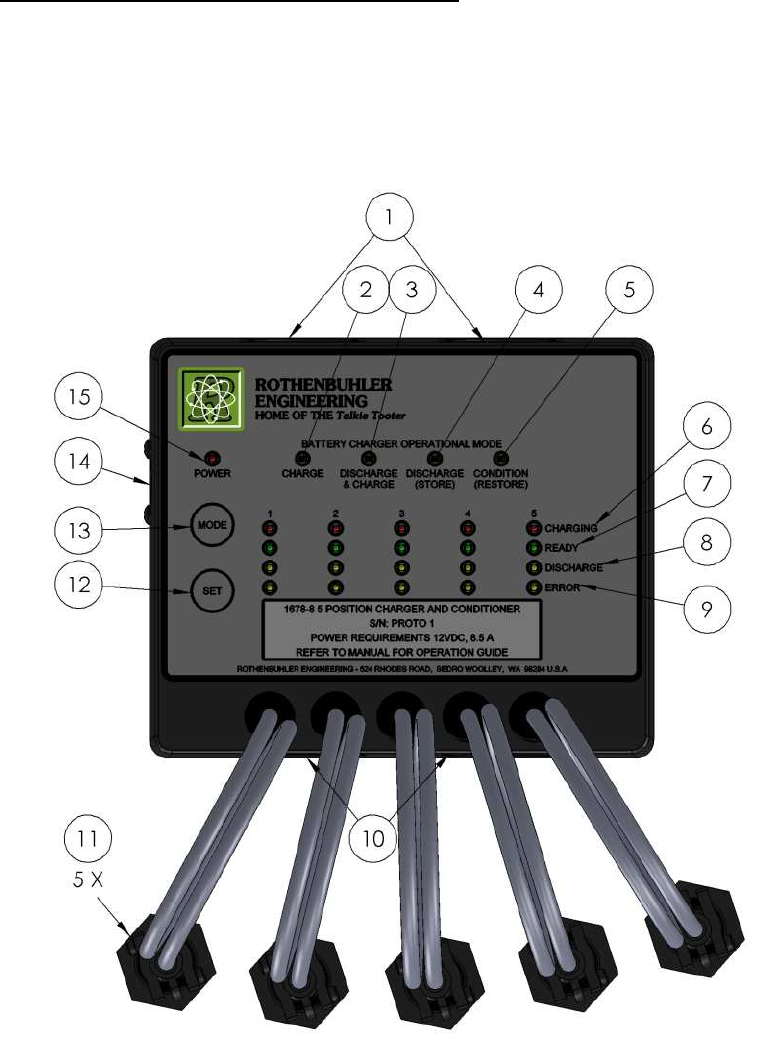
1678 RFD OPERATION MANUAL 36
4.4. 5 POSITION CHARGER & CONDITIONER
4.4.1. The battery pack in the Controller, Remote Units should be sufficiently
charged before use. Each 5 Position Charger & Conditioner has five independent
charge stations. Full charge time is about 2 hours. It will take less time for units that
are partially charged. Figure 4-1 and Table 4-1 provides details of the user interface.
Figure 4-1 5 Position Charger & Conditioner
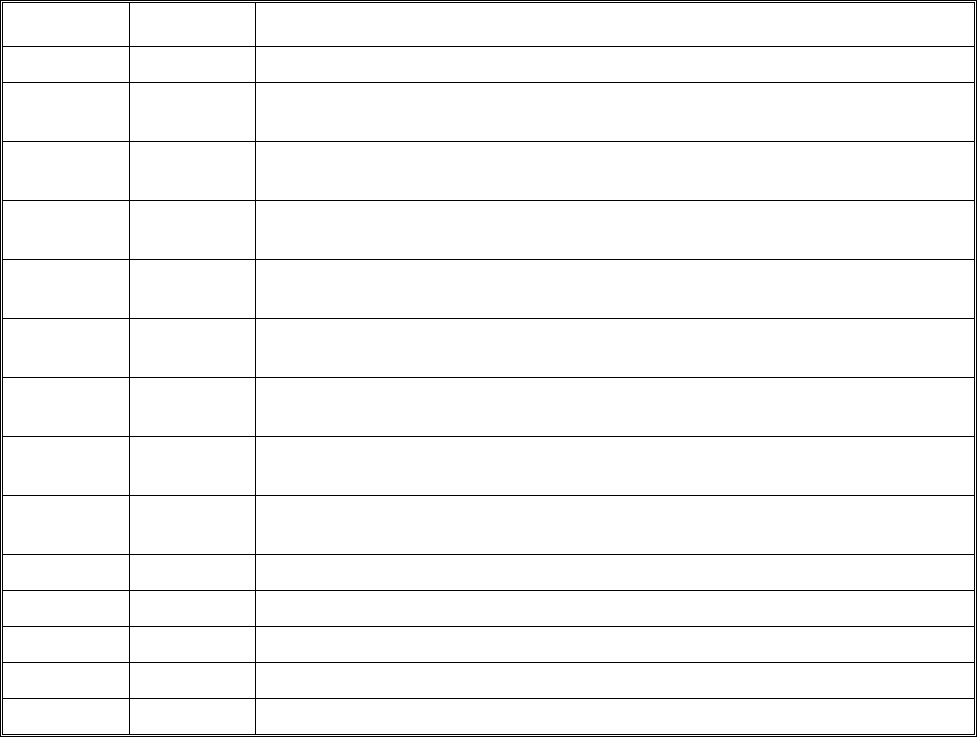
1678 RFD OPERATION MANUAL 37
Table 4-1 RFD 5 Position Charger & Conditioner
Figure Index No. Description
Figure 2-11 1 Cooling air inlets (x2).
Figure 2-11 2 System Charge Mode Indicator (yellow). Indicates the attached units will be
charged only (no discharge).
Figure 2-11 3 System Discharge then Charge Mode Indicator (yellow). Indicates the attached
units will receive a discharge, and then a charge.
Figure 2-11 4 System Discharge Mode Indicator (yellow). This mode is used to discharge the
batteries in preparation for storage.
Figure 2-11 5 System Condition Mode Indicator (yellow). This mode is used to restore
batteries that have been in storage.
Figure 2-11 6 Unit Charge Indicator (red, x5). This indicator lights when the attached unit is
charging.
Figure 2-11 7 Unit Ready Indicator (green, x5). This indicator lights when the attached unit
has completed its charge cycle.
Figure 2-11 8 Unit Discharge Indicator (yellow, x5). This indicator lights when the attached
unit is discharging.
Figure 2-11 9 Unit Error Indicator (yellow, x5). This indicator lights when the attached unit
has experienced a fault when charging.
Figure 2-11 10 Cooling air outlets (x2).
Figure 2-11 11 Charge cables (x5).
Figure 2-11 12 Set Switch, used to set the charger to operate in the selected Mode.
Figure 2-11 13 Mode Switch, used to select the mode of operation for the charger.
Figure 2-11 14 Power Jack, +12V DC.
4.4.2. Charge Mode provides a charge only of the connected units. The charge
time in Charge Mode is about 2 hours for fully discharged batteries. Less time is
required for units that have a partial charge. Charge Mode is usually used when rapid
deployment of the system is required.
4.4.3. Discharge & Charge Mode provides a full discharge of the connected units,
followed by a complete charge. A full Discharge & Charge Mode cycle requires about
5 hours for completion. This mode is recommended for normal use to ensure full
battery capacity and health.
4.4.4. Discharge (Store) Mode discharges the batteries down to a level that is
recommended when long term storage is required. The Condition (Restore) Mode
should be used to return units for use that have been stored.

1678 RFD OPERATION MANUAL 38
4.4.5. Condition (Restore) Mode helps to rejuvenate batteries. The Condition
(Restore) causes the battery to be discharged and charged repetitively until the
battery has reached its maximum charge capability. The Condition (Restore) Mode is
normally used to restore units from storage and to condition new batteries. The
Condition (Restore) Mode is also recommended for occasional use when low capacity
due to having developed a “battery memory” is suspected. The Condition (Restore)
Mode may require up to 17 hours for full charge conditioning.
4.4.6. The red CHARGING indicators (x5) light as each respective unit is charged.
When discharging, the yellow DISCHARGE indicators (x5) will light. As the units finish
their selected charging modes, the green READY indicators will light to show
completion. If a problem is detected during the charge process, the yellow ERROR
light will turn on.
4.5. 5 POSITION CHARGE PROCEDURE
4.5.1. Plug the supplied AC Power Adapter into an AC outlet. The AC Power
Adapter will operate from 100-240VAC, 50-60 Hz.
4.5.2. Insert the DC plug from the AC Power Adapter into the power jack on the
side of the charger. The POWER light will turn on.
CAUTION Do not open a vent if there is water on or near the vent. Keep the vents
closed when the relative humidity is above 90%. Take necessary precautions to ensure
moisture does not enter the unit case.
4.5.3. Open the vent on each unit to be charged.
4.5.4. Select the desired charger Operation Mode using the MODE switch. The
indicator for the chosen mode will blink.
4.5.5. Press the SET switch to set the chosen Operation Mode. The indicator for
the set mode will turn on steady.
4.5.6. Connect each unit to be charged to the 5 Position Charger & Conditioner.
The charger does not discriminate between Controller or Remote Units; any unit may
be connected to any of the 5 charge connectors. The units will begin to execute the
process for the Operation Mode that has been set.
4.5.7. At the beginning of a charge cycle, the red CHARGE light will blink briefly
and then turn on steady.
4.5.8. While discharging the battery, the yellow DISCHARGE light will be on.
4.5.9. As each unit completes its Operation Mode cycle, the READY lights will
illuminate.
1678 RFD OPERATION MANUAL 39
4.5.10. If a problem is detected during the charge cycle, the yellow ERROR light will
illuminate. Errors are used to indicate that the battery may be outside of its charge
temperature range, a faulty battery, or when an interruption to the charge process has
occurred.
4.5.11. The battery must be within the temperature range 32 ºF and 104 ºF (0 to
+40 ºC) for fast charging to occur.
4.5.12. Close the vent on each Remote Unit and the Controller after charging has
completed.

1678 RFD OPERATION MANUAL 40
4.6. BENCH TESTING THE SYSTEM
WARNING
Radio frequency energy of sufficient magnitude can cause blasting
caps to detonate.
4.6.1. The System test must be conducted in an area that is at least 100 feet (30
meters) from the nearest blasting caps, wires connected to blasting caps, or other
explosives.
4.6.2. All RFD System controls are described in detail in Section 2.
CAUTION All units must be thoroughly tested and the batteries fully charged prior
to operational use.
4.6.3. Install the Antenna Assembly on the antenna / battery charger connector of
the Controller. Ensure the Controller is off.
4.6.4. Install the Antenna Assemblies on the antenna / battery charger connectors
of the Remote Units. The ON/LOW BATT and SAFE lights will come on steady. If the
ON/LOW BATT light is flashing, the Remote Unit has a low battery. Recharge the
battery in accordance with Section 4.2.
4.6.5. Turn the Controller on by pressing the “ON” switch for 1 second. A yellow
light located in the upper left quadrant of the “ON” switch of the Mini Controller will turn
on steady. The “BAT” yellow light at the top of the Controller Unit display panel will
turn on. If the yellow light does not turn on steady, but flashes, this indicates a low
battery for the Controller. Recharge the battery in accordance with Section 4.2.
4.6.6. Press the “STATUS” switch for 1 second. The red TX light on the Controller
will start blinking for approximately 5 seconds. During that time the Controller is
requesting status from the Remote Units.
4.6.7. When the TX light stops flashing, the green SAFE light will come on steady
adjacent to the switches numbered “1” through “4” or “8”. A steady SAFE light
indicates that Remote Unit answered back with its status and it is disarmed. A
flashing SAFE light indicates the Controller did not receive the Remote Unit’s status
transmission.
WARNING
Ensure that blasting caps are not connected to any of the Remote
Units during bench testing.
4.6.8. Select all of the Remote Units by pressing switches “1” through “4” or “8”. A
yellow light will be lit in each switch to indicate the corresponding Remote Unit is
selected.
1678 RFD OPERATION MANUAL 41
4.6.9. Press the “ARM” switch for ½ second. The red ARMED light for each
selected Remote Unit will flash on the Controller display panel for approximately 5
seconds and then come on steady. The ARMED light for each selected Remote Unit
will grow brighter and then stay on steady. The Remote Units are now armed.
4.6.10. Observe the Controller and Remote Units. After the Arm Time Period
expires, the Remote Units will automatically disarm. The ARMED lights at the
Controller and Remote Units should turn off. The SAFE lights at the Controller and
SAFE lights at the Remote Units should turn on.
4.6.11. Re-Arm the Remote Units. Before the Arm Time Period expires, press the
“DISARM” switch on the Controller. The Controller's ARMED light will be turned off.
The SAFE lights at the Controller should blink for approximately 3 seconds and then
turn on steady. The ARMED lights at the Remote Units will turn off and the Remote
Units’ SAFE lights will turn on.
4.6.12. If firing RSTI Units, proceed to 4.6.13. Connect a test light assembly to the
binding posts of each Electric Remote Unit. Arm the Electric Remote Units. Press the
“FIRE” switch on the Controller. The test bulbs should flash brightly. The ARMED
light will turn off and the SAFE light will turn on at each Electric Remote Unit. The
displayed status at the Controller will change from ARMED to SAFE. Proceed to
4.6.14.
4.6.13. Install the firing tip into the Shock Tube Tip Jacks on the top of each RSTI.
Arm the RSTI Units. Press the “FIRE” switch on the Controller. Observe that bright
sparks should be heard and seen on each unit. The ARMED light will turn off and the
SAFE light will turn on at each RSTI. The displayed status at the Controller will
change from ARMED to SAFE.
Note:
When firing the RSTI with no tip or with a faulty tip, the green SAFE light for that
unit may not initially turn on following a FIRE operation. A subsequent press of the
“STATUS” switch illuminates the green SAFE light.
Note:
Refer to Section 2.7 for details about the RSTI and the Shock Tube Igniter Tip
handling and replacement. Never exceed 200 shots on your tip before replacement. If
you notice the spark is weak or if misfires occur, the tip needs replacement. Always
keep a spare tip as a backup. Keep the tip needle clean and dry. It is always
recommended to perform a test fire of the RSTI before use.
4.6.14. Turn off the Controller by pressing the “OFF” switch. Turn off the Remote
Units by removing their Antenna Assemblies.
4.6.15. The RFD system is now ready to use operationally.

1678 RFD OPERATION MANUAL 42
5. OPERATIONAL PROCEDURES
WARNING
Use of this system and its components must be restricted to personnel
qualified and experienced in the field of explosives and detonating devices. Under no
circumstances shall untrained personnel attempt to use this manual as a text for self-
teaching.
WARNING
Employ standard blasting system safety standards when using this
equipment with explosives.
WARNING
All units must be thoroughly tested and the batteries fully charged prior
to operational use.
5.1. READY THE SYSTEM AT SITE
5.1.1. Remote Units. Select the number of Electric Remote Units or RSTIs
required for the operation. Remove the dust cover from the antenna / battery charger
connector. Install the Antenna Assembly on to the antenna / battery charger
connector. This will turn on the Remote Unit. The yellow ON/LOW BATT light and
green SAFE light will be turned on. The green SAFE light will be on for the first
minute, whenever the Remote Unit is turned on and it is disarmed. In the disarmed
state, the firing capacitor charge circuit is disabled, the firing terminals are electrically
isolated from the firing capacitor, and the firing terminals are shunted to each other. If
the yellow ON/LOW BATT light is flashing, the Remote Unit battery is low and should
be recharged before use.
5.1.2. Remote Sleep Mode. If Sleep Mode is enabled, after 1 minute, the display
lights on the Remote Units will extinguish. During this time, the Remote unit is in a low
power ‘sleep’ state to conserve battery power. Sleep Mode can only be entered if the
Remote Unit is disarmed. The Remote units are quickly awakened by the Controller’s
radio signal when needed for use.
WARNING
Do not connect a blasting cap to a Remote Unit unless the green
SAFE light is on, the red ARMED light is off, and the yellow ON/LOW BATT light is on
steady. This indicates there is no voltage on the binding posts, the binding posts are
electically isolated from the firing capacitor, the binding posts are shunted to each other,
and the battery is not low.
5.1.3. Open and close the vent on each Remote Unit and the Controller to
equalize the case pressure. Unscrew the vent, one revolution, to open.
5.1.4. Remove the dust cover from the antenna / battery charger connector of the
Controller. Install the Antenna Assembly on to the antenna / battery charger
connector. This will enable the keypad on the Controller.

1678 RFD OPERATION MANUAL 43
WARNING
Do not use the Controller within 100 feet (30 meters) of explosives,
blasting caps, or wires leading to them. The Controller signal is 5 watts, which can
cause detonation of caps if within 100 feet. The 5 watt Controller complies with the
Recommended Table of Distances established by the Institute for the Makers of
Explosives (IME) when placed beyond 100 feet of explosives.
5.1.5. Turn the Controller on by pressing the “ON” switch for 1 second. A yellow
light located in the upper left quadrant of the Mini Controller’s “ON” switch will turn on
steady. The “BAT” yellow light at the top of the Controller Unit’s display panel will turn
on. If the yellow light does not turn on steady, but flashes, this indicates a low battery
for the Controller. Recharge the battery in accordance with Section 4.2.
5.1.6. Adjust the intensity of the LED display on the Controller for the desired
setting by repressing the ‘ON’ switch on the Controller.
5.1.7. Press the “STATUS” switch on the Controller. The red TX light will flash for
approximately 5 seconds. The green SAFE light corresponding to each Remote Unit
will come on steady if the Controller receives a status message from that Remote Unit.
If the Controller does not receive a status message from a Remote Unit, the green
SAFE light for that Remote Unit will flash on the Controller display panel.
Note:
The Controller battery life is approximately 6 hours when in the “ON” condition.
To conserve battery life, the Controller should be turned off when not being used.
5.1.8. Turn the Controller “OFF” until Remote Units are in place and wired to
shoot.
5.2. PLACEMENT OF REMOTE UNITS
WARNING
Do not connect a blasting cap to a Remote Unit unless the green
SAFE light is on, the red ARMED light is off, and the yellow ON/LOW BATT light is on
steady. This indicates there is no voltage on the binding posts, the binding posts are
electically isolated from the firing capacitor, the binding posts are shunted to each other,
and the battery is not low.
5.2.1. The range of the RFD is typically 5 miles under most conditions.
5.2.2. Place the Remote Units with the antenna in a vertical position and free from
obstruction within 100 feet (30 meters) of the shot. Use sandbags or other suitable
materials to protect the Remote Units from the shot.
5.2.3. Ensure that all Remote Units indicate a SAFE condition (green SAFE light
on steady).
5.2.4. If using the RSTI, proceed to Section 5.2.7. After performing standard
demolition circuit checks and before placing initiator into the main charge, depress the
two spring-loaded binding posts on the Electric Remote Unit.

1678 RFD OPERATION MANUAL 44
5.2.5. Insert one leg of the demolition wire in each binding post and allow the
binding posts to close on the wire ends.
5.2.6. Ensure the wire is held securely by the binding posts and that the wire ends
are not touching the Electric Remote’s case or each other. Proceed to Section 5.2.8.
5.2.7. Install the non-electric shock tubing onto the Shock Tube Tip and mount the
tip onto the RSTI according to Section 2.7. Take care to ensure no moisture or debris
enter the shock tube or contact the Shock Tube Tip’s needle.
5.2.8. Prepare the shot and return to the safe firing area.
5.2.9. If all Remote Units are located within 1 mile of the Controller, refer to
Section 5.3.
5.2.10. If all Remote Units are located more than 1 mile from the Controller, refer to
Section 5.4
5.2.11. If some Remote Units are located within 1 mile of the Controller, and other
Remote Units are more than 1 mile from the Controller, refer to Section 5.5.
5.3. SYSTEM OPERATION – REMOTE UNITS WITHIN 1 MILE OF CONTROLLER
Note:
If the distance between the Controller and the Remote Units is in excess of 1
mile, the Remote Units status transmissions may not be received by the Controller. The
Controller will command the Remotes from a distance greater than 1 mile, but the
Remote Status may not be confirmed. The Controller performs just as it would when it
is within 1 mile of the Remote Units. The only difference is the method the status
indications are displayed on the Controller display panel. The ARMED and SAFE status
lights for out of range Remote Units will flash on the Controller display panel to indicate
the Controller did not receive a status message from the Remote Unit. Once the
Remote Units are set up for the shot, the operator must assume the Remote Units have
received the command.
5.3.1. Ensure the area is clear.
5.3.2. Turn the Controller on.
5.3.3. Press the “STATUS” switch. The Controller will request status from all
Remote Units. The red TX light will flash for approximately 5 seconds. The green
SAFE light on the Controller display panel will come on steady for the Remote Units
that the Controller receives a disarmed status message from.
5.3.4. Select the Remote Units that are to be used in the shot by pressing the
corresponding numbered switches “1” through “4” or “8”. Press the numbered
switches one at a time.

1678 RFD OPERATION MANUAL 45
System Safety Feature
Once armed, the Remote Units must be sent a Fire
command within the Arm Time Period. If the Remote Units do not receive a Fire
command within the Arm Time Period, they will automatically disarm. The firing
capacitor will be safely internally discharged, the binding posts will remain isolated from
the firing capacitor and the binding posts will remain shunted together.
5.3.5. To arm the selected Remote Units, press the “ARM” switch. The red
ARMED light next to each selected Remote Unit switch will flash for approximately 5
seconds and then come on steady. The selected Remote Units are now ARMED!
5.3.6. To fire the Remote Units, press the “FIRE” switch and hold for 1 second.
The operator should get an indication of shot initiation. The ARMED light will go out
and the green SAFE light for each selected Remote Unit will come on steady on the
Controller display panel.
Note:
When firing the RSTI with no tip or with a faulty tip, the green SAFE light for that
unit may not initially turn on following a FIRE operation. A subsequent press of the
“STATUS” switch illuminates the green SAFE light.
5.3.7. If not all the Remote Units were selected for the shot, repeat above steps to
initiate the remaining shots.
5.3.8. To disarm any Remote Units that have been armed, select the Remote
Units and press the “DISARM” switch. All selected Remote Units will disarm in
approximately 3 seconds.
CAUTION Do not assume the DISARM command has been received by the
Remote Unit unless disarmed status is confirmed with a steady SAFE light for that
Remote Unit on the Controller display panel. If distance appears to be the problem,
move closer to the Remote Unit following standard procedures for this type of situation.
The “STATUS” and/or “DISARM” switches may be pressed repeatedly as the Remote
Unit is approached. Maintain a safe distance from the Remote Unit. Do not approach
the Remote Unit until disarmed status is confirmed with a steady SAFE light for that
Remote Unit on the Controller display panel. Under no conditions should the “FIRE”
switch be pressed as the Remote Unit is approached. DO NOT bring the Controller
closer than 100 feet (30 meters) to blasting caps, wires connected to blasting caps, or
other explosives.
5.3.9. Turn off the Controller.
5.3.10. Recover the fielded Remote Units.
5.3.11. Refer to Post Operational Procedures in chapter 5.5.14.
5.4. SYSTEM OPERATION – REMOTE UNITS MORE THAN 1 MILE BUT LESS
THAN 5 MILES FROM CONTROLLER
1678 RFD OPERATION MANUAL 46
Note:
If the distance between the Controller and the Remote Units is in excess of 1
mile, the Remote Units status transmissions may not be received by the Controller. The
Controller will command the Remotes from a distance greater than 1 mile, but the
Remote status may not be confirmed. The Controller performs just as it would when it
is within 1 mile of the Remote Units. The only difference is the method the status
indications are displayed on the Controller display panel. The ARMED and SAFE status
lights for out of range Remote Units will flash on the Controller display panel to indicate
the Controller did not receive a status message from the Remote Unit. Once the
Remote Units are set up for the shot, the operator must assume the Remote Units have
received the command.
5.4.1. Ensure the area is clear.
5.4.2. Turn the Controller on.
5.4.3. Press the “STATUS” switch. The Controller will request status from all
Remote Units. The red TX light will flash for approximately 5 seconds. The green
SAFE light on the Controller display panel will flash for all Remote Units that the
Controller does not receive a status message from.
5.4.4. Select the Remote Units that are to be used in the shot by pressing the
corresponding numbered switches “1” through “4” or “8”. Press the numbered
switches one at a time.
System Safety Feature
Once armed, the Remote Units must be sent a Fire
command within the Arm Timeout Period. If the Remote Units do not receive a Fire
command within the Arm Timeout Period, they will automatically disarm. The firing
capacitor will be safely internally discharged, the binding posts will remain isolated from
the firing capacitor and the binding posts will remain shunted together.
5.4.5. To arm the selected Remote Units, press the “ARM” switch. The red
ARMED light next to each selected Remote Unit switch will flash for 5 seconds, then
come on steady for two seconds, and then continue to flash. The selected Remote
Units are now assumed to be ARMED!
5.4.6. To fire the Remote Units, press the “FIRE” switch. The operator should get
an indication of shot initiation. The ARMED light will go out and the green SAFE light
for each selected Remote Unit will flash on the Mini Controller Unit display panel.
5.4.7. If not all the Remote Units were selected for the shot, repeat above steps to
initiate the remaining shots.
5.4.8. To disarm any Remote Units that have been armed, select the Remote
Units and press the “DISARM” switch. All selected Remote Units will disarm in
approximately 3 seconds.

1678 RFD OPERATION MANUAL 47
CAUTION Do not assume the DISARM command has been received by the
Remote Unit unless disarmed status is confirmed with a steady SAFE light for that
Remote Unit on the Controller display panel. If distance appears to be the problem,
move closer to the Remote Unit following standard procedures for this type of situation.
The “STATUS” and/or “DISARM” switches may be pressed repeatedly as the Remote
Unit is approached. Maintain a safe distance from the Remote Unit. Do not approach
the Remote Unit until disarmed status is confirmed with a steady SAFE light for that
Remote Unit on the Controller display panel. Under no conditions should the “FIRE”
switch be pressed as the Remote Unit is approached. DO NOT bring the Controller
closer than 100 feet (30 meters) to blasting caps, wires connected to blasting caps, or
other explosives.
5.4.9. Turn off the Controller.
5.4.10. Recover the fielded Remote Units.
5.4.11. Refer to Post Operational Procedures in chapter 5.5.14.
5.5. SYSTEM OPERATION – REMOTE UNITS BOTH WITHIN AND IN EXCESS OF
1 MILE FROM CONTROLLER
Note:
If the distance between the Controller and the Remote Units is in excess of 1
mile, the Remote Units status transmissions may not be received by the Controller. The
Controller will command the Remotes from a distance greater than 1 mile, but the
Remote status may not be confirmed. The Controller performs just as it would when it
is within 1 mile of the Remote Units. The only difference is the method the status
indications are displayed on the Controller display panel. The ARMED and SAFE status
lights for out of range Remote Units will flash on the Controller display panel to indicate
the Controller did not receive a status message from the Remote Unit. Once the
Remote Units are set up for the shot, the operator must assume the Remote Units have
received the command.
5.5.1. The RFD will operate in a two-way mode (confirmed communications –
range less than 1 mile) and one-way mode (unconfirmed communications – range
greater than 1 mile).
5.5.2. If the Remotes are within 1 mile of the Controller, the status of the Remote
Units (ON/LOW BATT, ARMED, and SAFE) will be displayed with steady lights on the
display panel of the Controller.
5.5.3. If one or more Remote Units are out of range of the Controller, the status of
these Remote Units will be assumed and their status lights will flash on the Controller
display panel to indicate unconfirmed status. Accordingly the operator must assume
the following:
• Commands have been received by the Remote Units.
1678 RFD OPERATION MANUAL 48
• The Remote Unit battery is sufficiently charged to activate the firing circuit.
• A DISARM command should not be assumed.
5.5.4. Ensure the area is clear.
5.5.5. Turn the Controller on.
5.5.6. Press the “STATUS” switch. The Controller will request status from all
Remote Units. The red TX light will flash for approximately 5 seconds. The green
SAFE light on the Controller display panel will flash for all the Remote Units that the
Controller does not receive a status message from.
5.5.7. Select the Remote Units that are to be used in the shot by pressing the
corresponding numbered switches “1” through “4” or “8”. Press the numbered
switches one at a time.
System Safety Feature
Once armed, the Remote Units must be sent a Fire
command within the Arm Time Period. If the Remote Units do not receive a Fire
command within the Arm Time Period, they will automatically disarm. The firing
capacitor will be safely internally discharged, the binding posts will remain isolated from
the firing capacitor and the binding posts will remain shunted together.
5.5.8. To arm the selected Remote Units, press the “ARM” switch. The red
ARMED light next to each selected Remote Unit switch will flash for 5 seconds, and
then come on steady for two seconds. ARMED lights for selected Remote Units that
the Controller did not receive a status message from will begin to flash again. The
selected Remote Units are now assumed to be ARMED! For unconfirmed
communications, count to 5 from when the "ARM" switch is pressed and assume the
Remote Units are armed.
5.5.9. To fire the Remote Units, press the “FIRE” switch. The operator should get
an indication of shot initiation. The ARMED light will go out and the green SAFE light
for each selected Remote Unit will flash on the Controller display panel.
5.5.10. If not all the Remote Units were selected for the shot, repeat above steps to
initiate the remaining shots.
5.5.11. To disarm any Remote Units that have been armed, select Remote Units
and press the “DISARM” switch. All selected Remote Units will disarm in
approximately 3 seconds.
1678 RFD OPERATION MANUAL 49
CAUTION Do not assume the DISARM command has been received by the Remote
Unit unless disarmed status is confirmed with a steady SAFE light for that Remote Unit
on the Controller display panel. If distance appears to be the problem, move closer to
the Remote Unit following standard procedures for this type of situation. The “STATUS”
and/or “DISARM” switches may be pressed repeatedly as the Remote Unit is
approached. Maintain a safe distance from the Remote Unit. Do not approach the
Remote Unit until disarmed status is confirmed with a steady SAFE light for that Remote
Unit on the Controller display panel. Under no conditions should the “FIRE” switch be
pressed as the Remote Unit is approached. DO NOT bring the Controller closer than
100 feet (30 meters) to blasting caps, wires connected to blasting caps, or other
explosives.
5.5.12. Turn off the Controller.
5.5.13. Recover the fielded Remote Units.
5.5.14. Refer to Post Operational Procedures in chapter 6.

1678 RFD OPERATION MANUAL 50
6. POST OPERATIONAL PROCEDURES
6.1. SECURING THE SYSTEM
6.1.1. Turn the Controller off and remove the Antenna Assembly. This action
disables the Controller.
6.1.2. Replace the dust cover on the antenna / battery charger connector on the
Controller and replace the plastic cap on the Antenna Assembly.
6.1.3. Remove the Antenna Assemblies from the Remote Units. This action turns
off the Remote Units.
6.1.4. Replace the dust cover on the antenna / battery charger connector on the
Remote Units and replace the plastic cap on the Antenna Assembly.
6.2. PHYSICAL INSPECTION
6.2.1. Inspect the Controller and Remote Units for physical damage.
6.2.2. Inspect the units for dirt or corrosion around/on connector pins and vent.
6.2.3. Replace any unit found to have damage. Return unit to manufacturer.
6.2.4. Clean units using a soft bristle brush.
6.2.5. If a unit cannot be cleaned by brushing, make sure the vent is closed
securely and wash units in warm soapy water.
6.2.6. Rinse units with clean water and dry thoroughly.
6.2.7. Inspect units for damage. Replace as necessary.
6.3. PACKAGING
6.3.1. Re-package all components in carrying case.
6.4. MAINTENANCE & EQUIPMENT STORAGE
6.4.1. Periodic battery charging
6.4.2. Check for signs of corrosion around and on connector pins.

1678 RFD OPERATION MANUAL 51
7. BASIC TROUBLESHOOTING IN THE FIELD
7.1. REMOTE UNITS
7.1.1. ON and SAFE lights do not illuminate when the Antenna Assembly is
installed.
a) Check Antenna Assembly and make sure it is seated, “clicks” on to the connector.
b) Recharge the battery.
c) Try a different Antenna Assembly.
7.2. CONTROLLER
7.2.1. ON Light does not stay on.
a) Check Antenna Assembly and make sure it is seated, “clicks” on to the connector.
b) Press and hold the “ON” switch for 5 seconds.
c) Controller battery needs to be recharged.
7.2.2. Command receipt is not confirmed by Remote Unit.
a) Remote Unit is more than 1 mile from Controller.
b) If the Remote Unit is less than 1 mile away from the Controller:
Check for damage to Controller Antenna Assembly.
Try a different Antenna Assembly on the Controller.
Move at least 25 feet in any direction and try again.
Reposition the Remote Unit if:
• The antenna is not positioned vertically.
• The antenna is next to another radio antenna.
• The antenna is surrounded by metallic objects.
• Use optional magnetic mount antenna for improved gain. This antenna is
available by special order only.
7.3. REMOTE SHOCK TUBE INITIATOR
7.3.1. Unit will not ignite the shock tube.
a) The Shock Tube Tip may be worn or damaged. Replace tip.
b) The shock tube may be damaged from moisture. Try a fresh cut or replace the
tubing. Ensure the tube covers the entire needle. Ensure both the needle and
the shock tube lead-in is dry when mating.
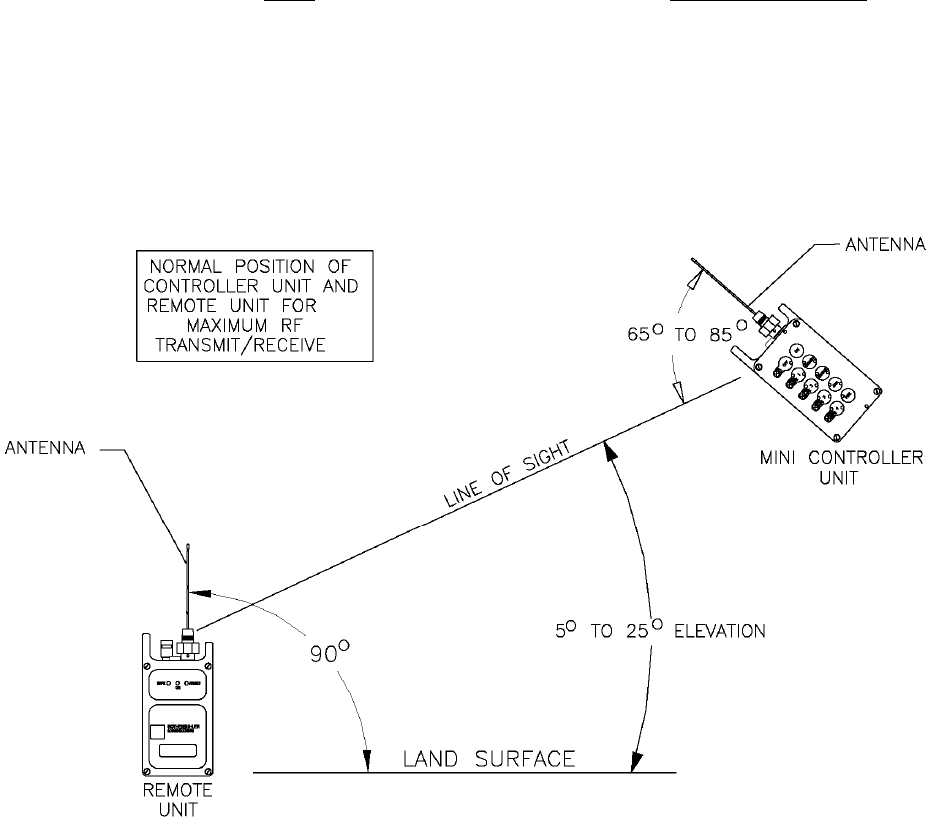
1678 RFD OPERATION MANUAL 52
8. OPTIMIZING RANGE
8.1.1. When power lines are in the area, the radio transmission distance is
reduced. The system can operate at the following distance, when the Controller is
elevated to a maximum transmission location angle to the Remote Unit location (see
Figure 8-1).
Over Minimum Distance
Open Land or Water with Power Lines 1 mile
Dense Vegetation without Power Lines 1 mile
Open Land or Water without Power Lines Greater than 5 Miles
Figure 8-1 Unit Normal Transmission Location
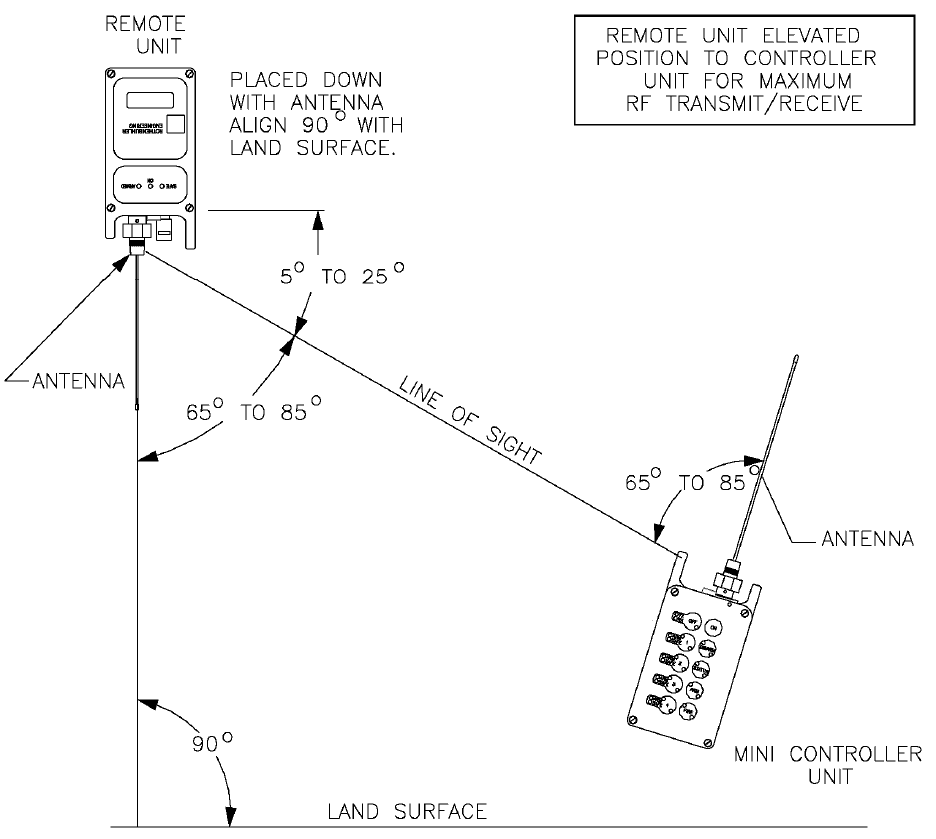
1678 RFD OPERATION MANUAL 53
8.1.2. If the Controller and Remote Unit must be placed in a position other than
location in Figure 8-1, use Figure 8-2 or Figure 8-3. The minimum transmission will
occur when the Controller antenna and the Remote Unit antenna are placed in the line
of site. The maximum transmission occurs when the line of site lays in a path of 5 to
25 degrees above unit top plane perpendicular to the antenna. Both the Controller
antenna and the Remote Unit antenna have the same radiant energy pattern as
shown in Figure 8-4.
Figure 8-2 Remote Unit Elevated
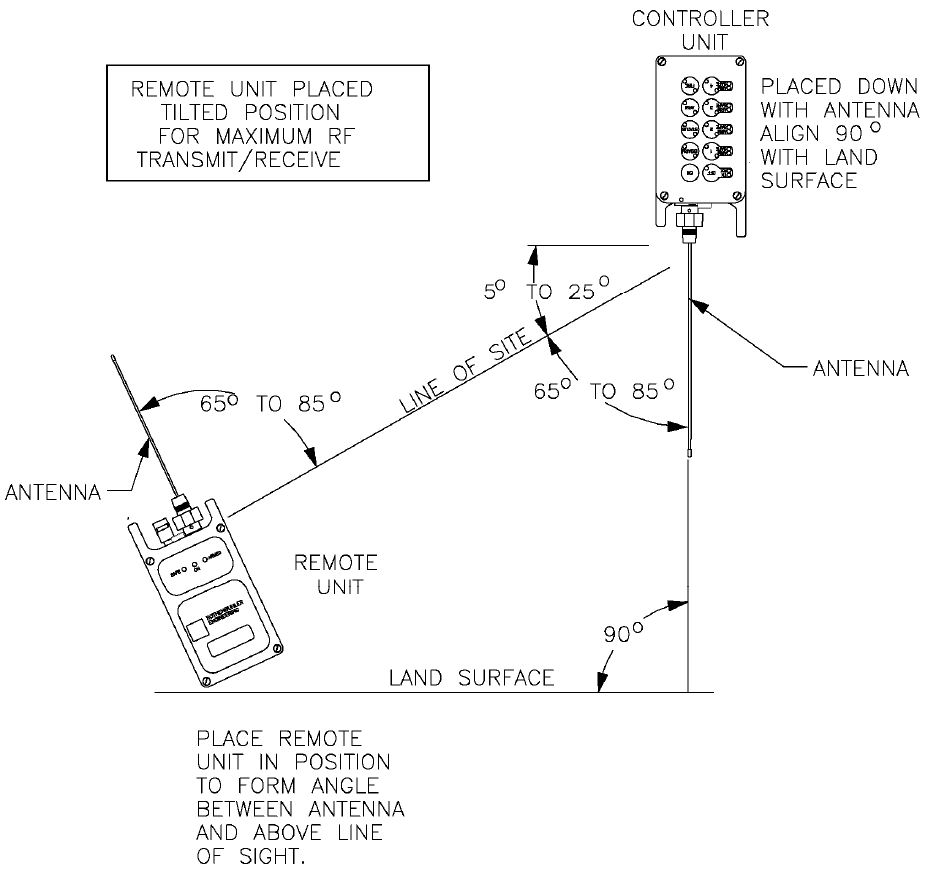
1678 RFD OPERATION MANUAL 54
Figure 8-3 Mini Controller Unit Elevated
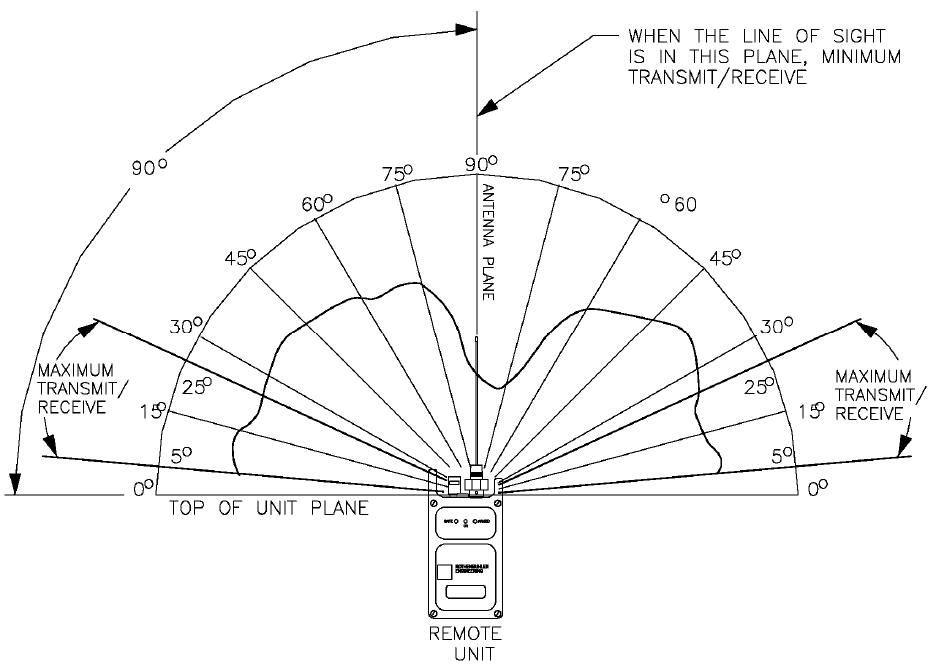
1678 RFD OPERATION MANUAL 55
Figure 8-4 Antenna Radiation Pattern (All Units)
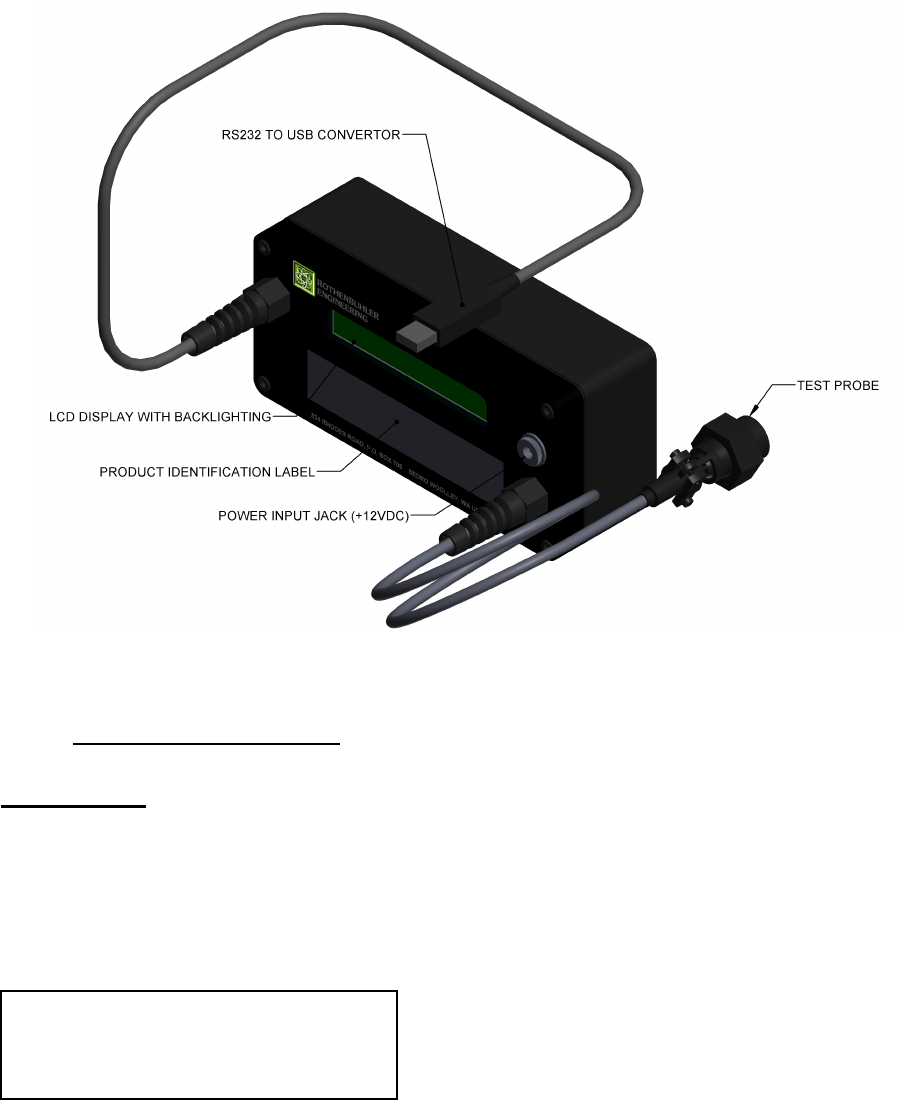
1678 RFD OPERATION MANUAL 56
9. TEST BOX
The Test Box allows the user to test display system information of the Electric Remote,
RSTI, and Mini Controller Units as well as perform diagnostic checks. The Test Box
also serves as the programming interface between a computer and a RFD Unit.
Figure 9-1 Test Box
9.1. TEST BOX OPERATION
WARNING
Do not touch the firing terminals of the Remote units while testing. A
potentially lethal voltage is present during the Fire test.
9.1.1. Test Box Messages
When the Test Box is turned on, the following message is displayed.
1678 Test Box
01/13/2011 Ver 3.0

1678 RFD OPERATION MANUAL 57
The “1678 Test Box” part of the message identifies the system types that the Test Box
is designed to operate with. “01/13/2011” is the date of the Test Box firmware. “Ver
3.0” is the version of the Test Box firmware. The Test Box will automatically step to the
next message “Connect Unit to Test”.
9.1.2. Testing the Controller
To test a Controller, plug the Test Box probe into the top connector on the Controller.
Then press the ‘ON’ Switch while pressing the Select ‘3’ switch. The Controller turns on
with the yellow light next to the Select ‘3’ switch illuminated. The Test Box will display
the following message. The actual message will depend on the model of Controller.
Next the Test Box will display the Battery Charge Count as shown below. This is the
number of charge cycles the battery within the Controller has experienced.
Next the Test Box displays the current battery’s temperature (+22C +72F) and
chemistry type (NiMH).
The next message shows the battery serial number (Battery SN 0001) and the battery’s
date of manufacture (Battery DOM 02/03/2011).
Battery Temp +22C +72F
Battery Type: 1650mAh NiMH
Battery SN 0001
Battery DOM 02/03/2011
Battery Charge Count
83
Mini Controller Detected
Connect Unit to Test
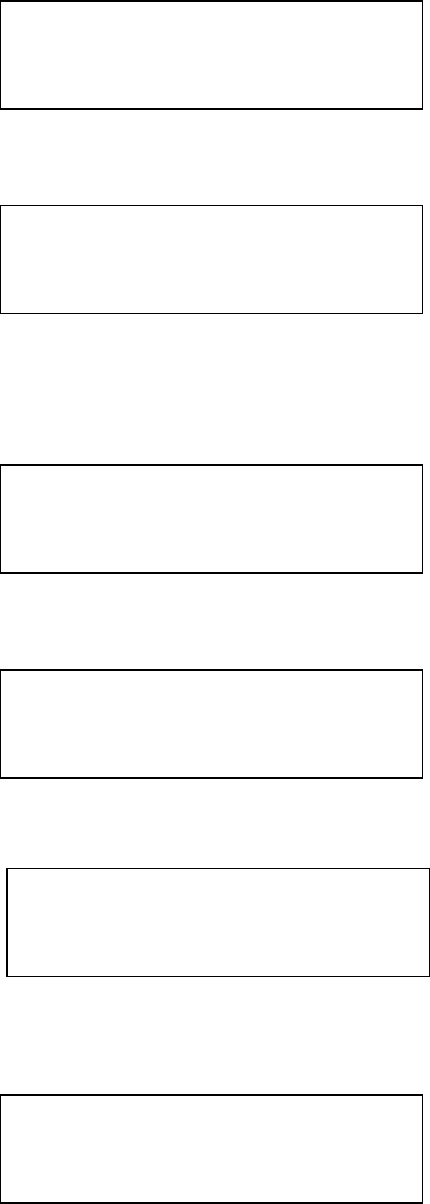
1678 RFD OPERATION MANUAL 58
The next message displayed shows the System Number or Address (0000000001) that
the Controller is assigned to and the Unit assigned to the Controller (Default is Unit 1).
The next message displayed shows the assigned Frequency.
The next message displayed is the Controller’s serial number (S/N), unit Type (Model)
date of manufacture (DOM), firmware version (Ver). The actual message will depend
on the model of Controller.
The next message displayed is the firmware Checksum and the Fire Count.
Next the Controller begins a Battery Test.
The Battery Test places a load on the battery and a countdown timer is started. At the
end of the test, the loaded battery voltage is displayed along with the test limit of (7.00).
Loaded Battery 7.24
<Low Battery = 7.00>
Battery Test – Standby
30
Checksum 4C42
Fire Count 87
S/N 00101 Type 1678-6
DOM 06/29/2010 Ver 1.0
Frequency 174 MHz
Address 0000000001
Unit 1

1678 RFD OPERATION MANUAL 59
After testing is complete, the Controller’s loaded battery voltage is displayed.
9.1.3. Testing the Electric Remote
WARNING
Do not touch the firing terminals of the Remote units while testing. A
potentially lethal voltage is present during the Fire test.
To test an Electric Remote, plug the Test Box probe into the top connector on the
Electric Remote. The Electric Remote turns on with the yellow light fast blinking and the
green light on. The Test Box will display the following message.
Next the Test Box will display the Battery Charge Count as shown below. This is the
number of charge cycles the battery within the Electric Remote has experienced.
Next the Test Box displays the current battery’s temperature (+22C +72F) and
chemistry type (NiMH).
The next message shows the battery serial number (Battery SN 0001) and the battery’s
date of manufacture (Battery DOM 02/03/2011).
Battery Temp +22C +72F
Battery Type: 1650mAh NiMH
Battery SN 0001
Battery DOM 02/03/2011
Battery Charge Count
83
Electric Remote Detected
Battery Voltage 7.24

1678 RFD OPERATION MANUAL 60
The next message displayed shows the System Number or Address (0000000001) and
the Unit number assigned to the Electric Remote.
The next message displayed shows the assigned Frequency.
The next message displayed is the Electric Remote’s serial number (S/N), unit Type
(Model) date of manufacture (DOM), firmware version (Ver).
The next message displayed is the firmware Checksum and the Fire Count.
Next the Electric Remote begins the Electric Arm/Fire Test. The Test Box Arms the
Electric Remote and begins 5 second countdown.
At the end of the countdown the Electric Remote is fired. The firing voltage and pass
level is shown.
Arm/Fire Voltage 50.23
<Pass Level = 45.00>
Electric Arm/Fire Test
05
Checksum 7061
Fire Count 87
S/N 00101 Type 1678-2
DOM 06/29/2010 Ver 1.0
Frequency 174 MHz
Address 0000000001
Unit 2
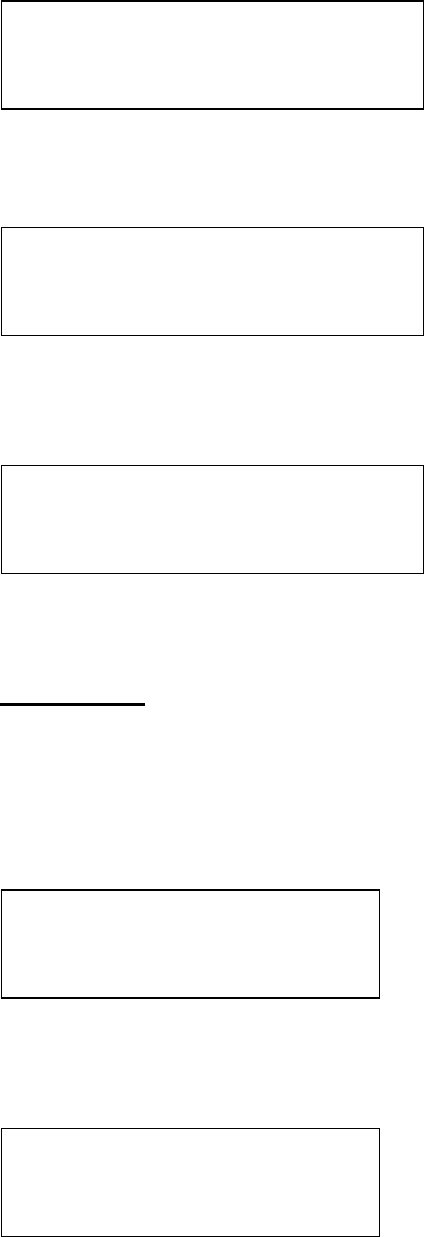
1678 RFD OPERATION MANUAL 61
Next the Electric Remote begins a Battery Test.
The Battery Test places a load on the battery and a countdown timer is started. At the
end of the test, the loaded battery voltage is displayed along with the test limit of (7.00).
After testing is complete, Electric Remote’s loaded battery voltage and firing voltage are
displayed.
9.1.4. Testing the RSTI
WARNING
Do not touch the firing terminals of the Remote units while testing. A
potentially lethal voltage is present during the Fire test.
To test an RSTI, install the firing tip on the top of the RSTI and plug the Test Box probe
into the top connector on the RSTI. The RSTI turns on with the yellow light fast blinking
and the green light on. The Test Box will display the following message.
Next the Test Box will display the Battery Charge Count as shown below. This is the
number of charge cycles the battery within the RSTI has experienced.
Battery Charge Count
83
RSTI Detected
Loaded Battery 7.24
<Low Battery = 7.00>
Battery Test – Standby
30
Battery Voltage 7.24
Firing Voltage 51.54

1678 RFD OPERATION MANUAL 62
Next the Test Box displays the current battery’s temperature (+22C +72F) and
chemistry type (NiMH).
The next message shows the battery serial number (Battery SN 0001) and the battery’s
date of manufacture (Battery DOM 02/03/2011).
The next message displayed shows the System Number or Address (0000000001) and
the Unit that the RSTI is assigned to.
The next message displayed shows the assigned Frequency.
The next messages displayed are the serial number (S/N), unit Type (Model) date of
manufacture (DOM), firmware version (Ver).
The next message displayed is the firmware Checksum and the Fire Count.
Checksum 56c4
Fire Count 87
S/N 00101 Type 1678-3
DOM 06/29/2010 Ver 1.0
Frequency 174 MHz
Address 0000000001
Unit 3
Battery Temp +22C +72F
Battery Type: 1650mAh NiMH
Battery SN 0001
Battery DOM 02/03/2011

1678 RFD OPERATION MANUAL 63
Next the RSTI begins the Arm/Fire Test. The Test Box Arms the RSTI and begins 5
second countdown.
At the end of the countdown, the RSTI fires resulting in the formation of a spark at the
tip. The firing voltage and pass level is shown.
Next the RSTI begins a Battery Test.
The Battery Test places a load on the battery and a countdown timer is started. At the
end of the test, the loaded battery voltage is displayed along with the test limit of (7.00).
After testing is complete, the following message is displayed.
Loaded Battery 7.24
<Low Battery = 7.00>
Battery Test – Standby
30
Battery Voltage 7.24
Firing Voltage 2652
Firing Voltage 2652
<Pass Level = 2250>
RSTI Arm/Fire Test
05
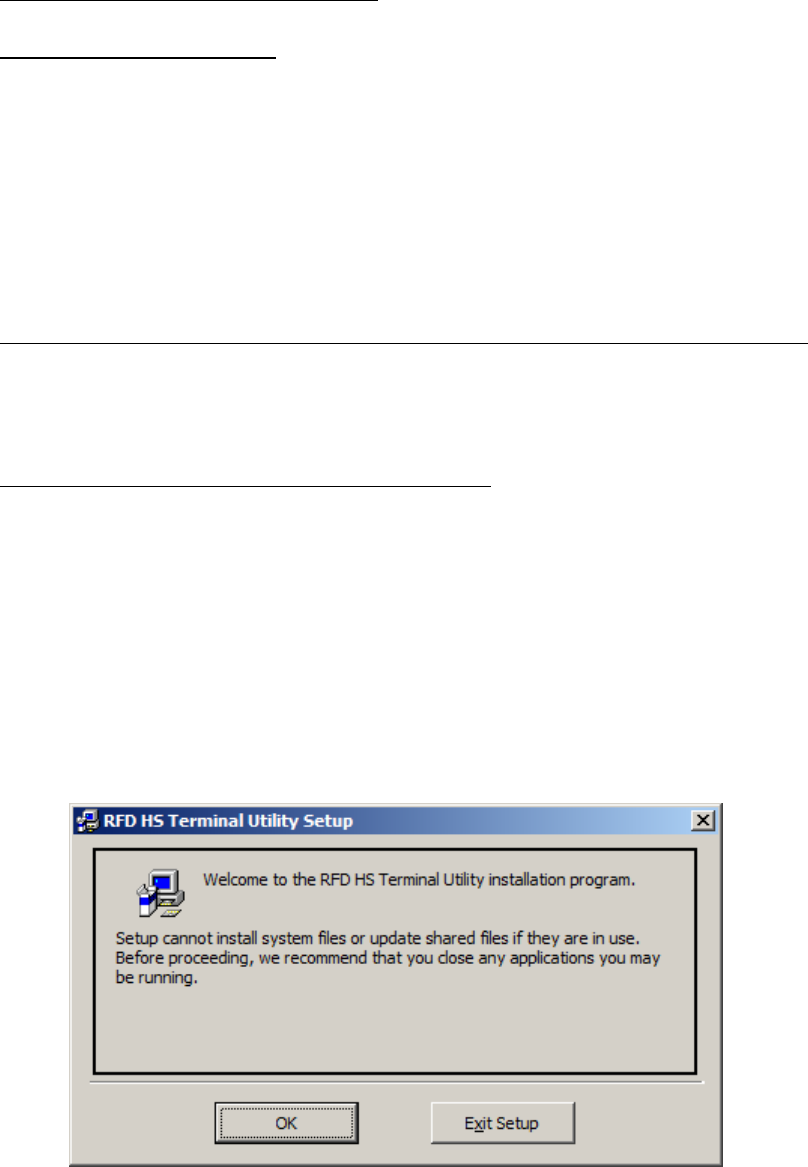
1678 RFD OPERATION MANUAL 64
RFD Programming Guide
9.2. PROGRAMMABLE PARAMETERS
9.3. REQUIRED EQUIPMENT
9.3.1. 1678 Test Box
9.3.2. A personal computer running Microsoft Windows® 95, 98, 2000, or XP and
an available USB port.
9.3.3. The software utility ‘RFD HS Terminal Utility’ located on the CD at the back
of this manual.
9.4. WINDOWS CONFIGURATION SOFTWARE (RFD HS TERMINAL UTILITY)
RFD HS Terminal Utility is a Windows program which allows users to log the test results
from the Text Box into a PC.
9.5. RFD HS TERMINAL UTILITY INSTALLATION
The RFD HS Terminal Utility install files are distributed on a CD. Follow the listed steps
to install RFD HS Terminal Utility on a computer.
• Install the CD and browse to the file ‘Setup.exe’.
• Run the setup.exe file from the folder.
• Follow the prompts in the dialog boxes that appear. Typical dialog boxes are
shown below.
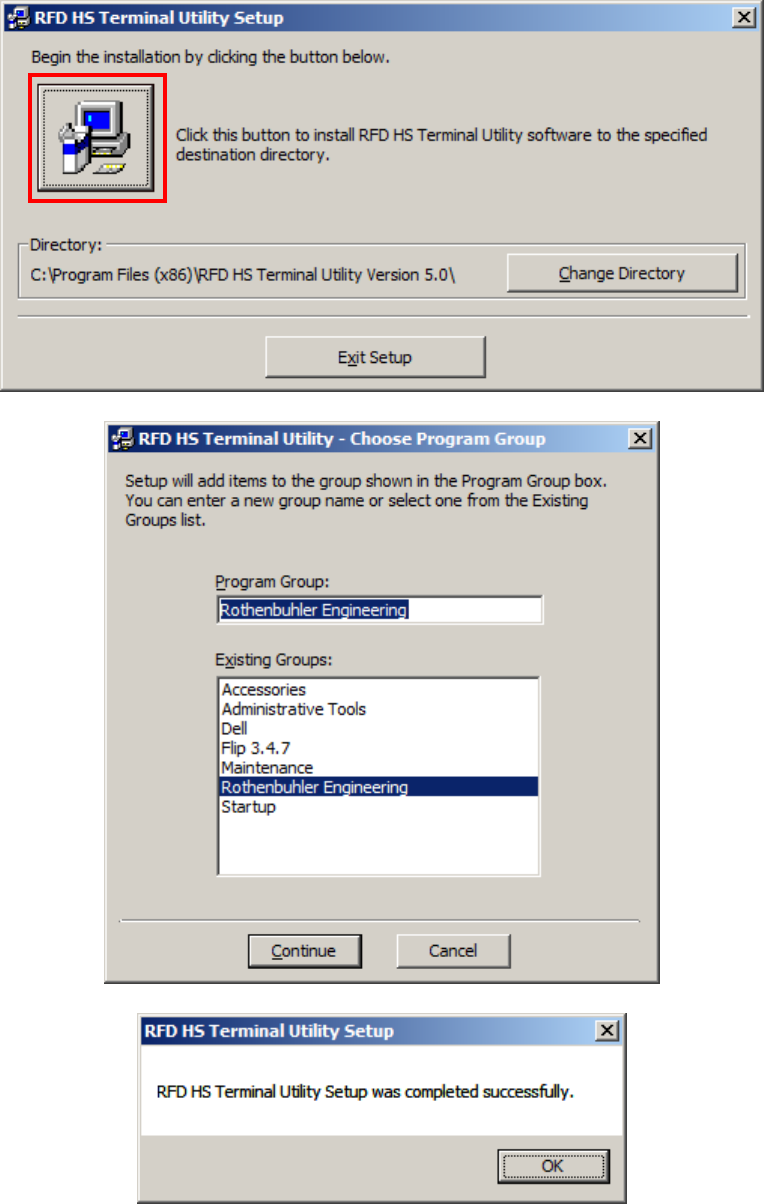
1678 RFD OPERATION MANUAL 65
RFD Terminal Utility is now installed on the computer.
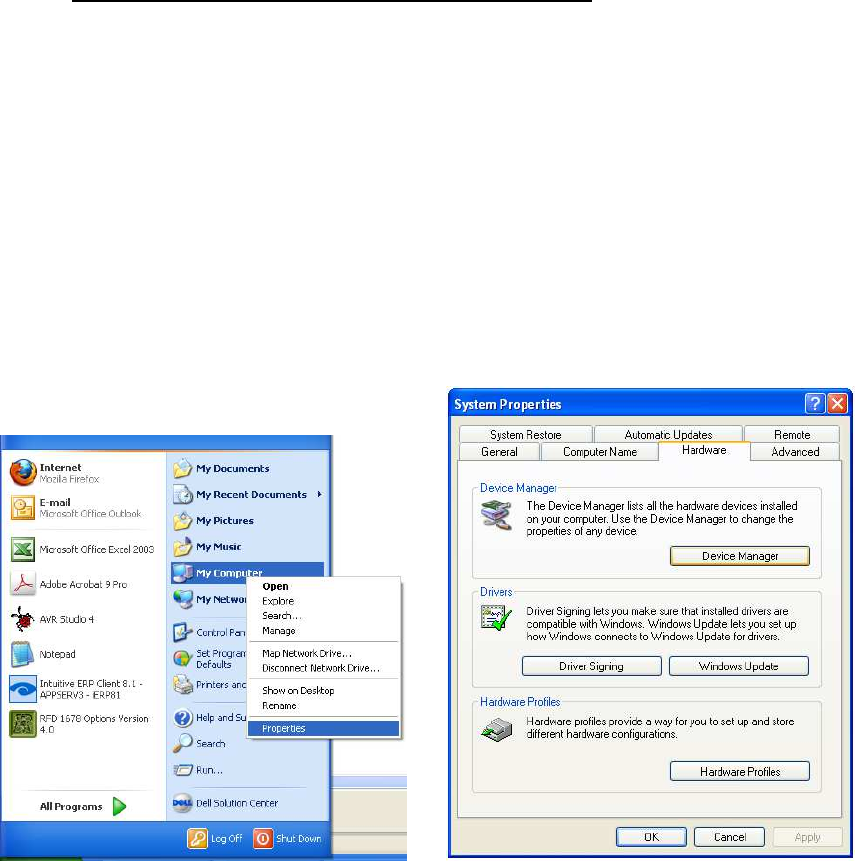
1678 RFD OPERATION MANUAL 66
9.6. INSTALLING TEST BOX USB CABLE DRIVERS
1. Connect the USB cable from the 1678-4 RFD Test Box to a USB port on the PC.
2. If the automatic installation takes place there is no need to continue with the
procedure outlined below. If the automatic installation does not find the USB drivers,
browse to the RFD HS Terminal Utility install disk and then the “Rothenbuhler USB
Drivers” folder. The folder contains the required drivers and the automatic
installation should then be able to complete.
3. After installation is completed, press the Windows start button to bring up the start
menu and right click on My Computer.
4. Select Properties.
5. Select the Hardware Tab, and click on Device manager.
6. A Rothenbuhler RFD Test Box USB Serial Port should be listed under Ports (COM &
LPT). Make a note of the COM number assigned to the Test Box.
7. If the Rothenbuhler RFD Test Box USB Serial port is not listed under PORTS (COM
& LPT) then expand the Universal Serial Bus Controllers tab.
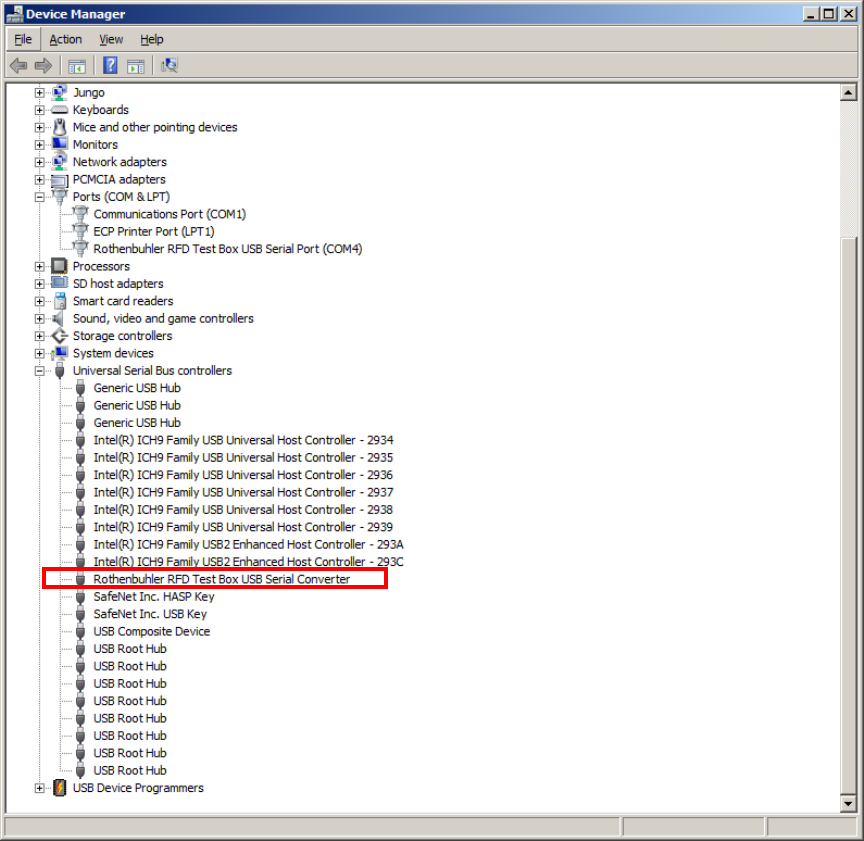
1678 RFD OPERATION MANUAL 67
8. Select the Rothenbuhler RFD Test Box USB Serial Convertor, and right click to open
its properties.
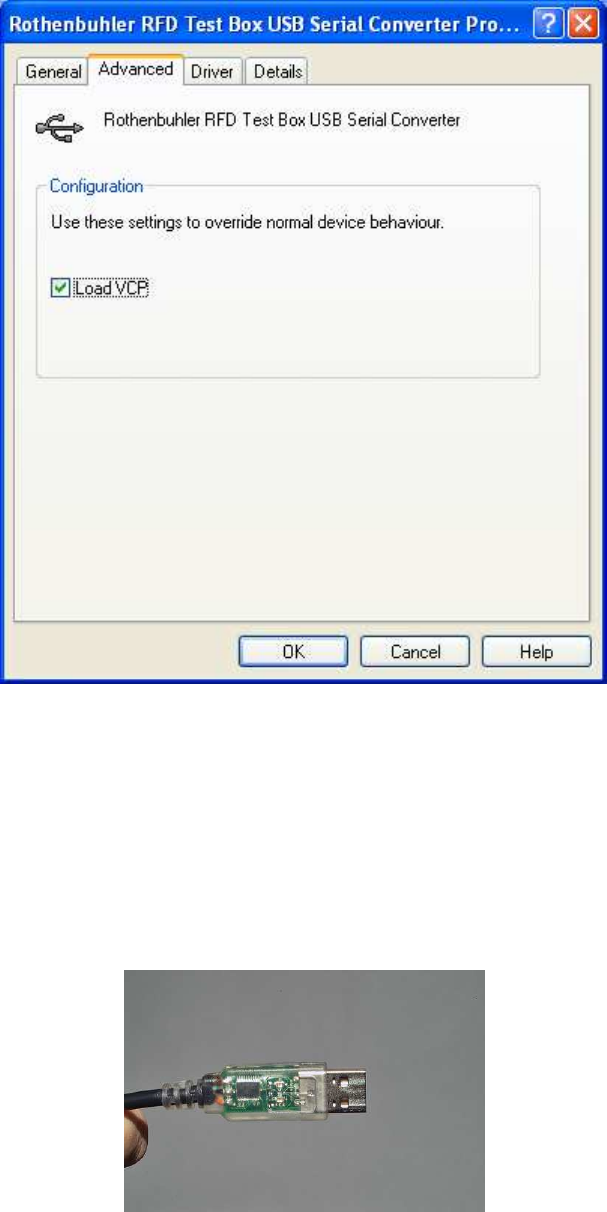
1678 RFD OPERATION MANUAL 68
9. Open the Advanced tab and make sure the Load VCP box is checked. It maybe
necessary to disconnect and reconnect the USB cable to refresh the list.
10. Note the COM number that has been assigned to the Test Box. The COM number
will be necessary when connecting to the RFD HS Terminal Utility Software.
11. Note that the COM port assigned to the Test Box may change if the USB cable is
plugged into a different USB port on the computer.
12. Before starting the RFD HS Terminal Utility, connect the USB cable from the 1678-4
RFD Test Box to a USB port on the PC.
13. Open the RFD HS Terminal Utility program and select the COM Port that was
assigned by the computer’s Hardware Manager to the Test Box.
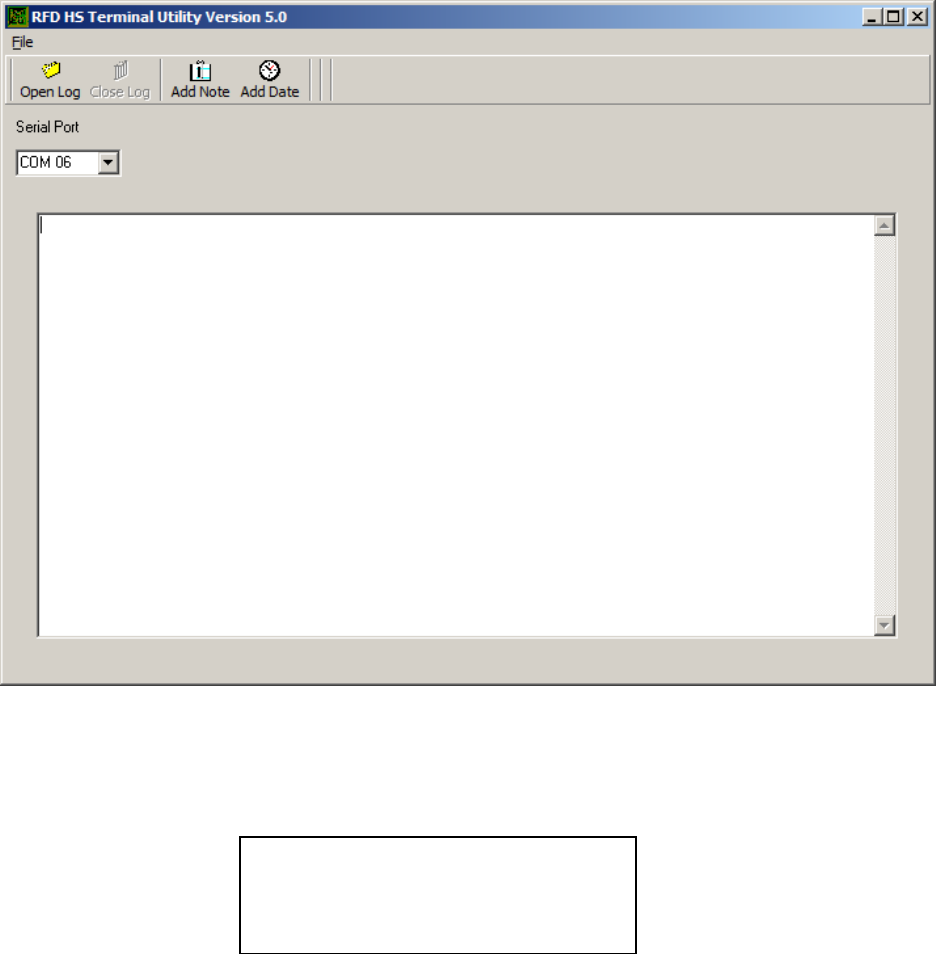
1678 RFD OPERATION MANUAL 69
14. Plug in the power input jack on the top right of the Test Box. Observe the display on
the Test Box. It should read “Connect Unit to Test.”
Connect Unit to Test
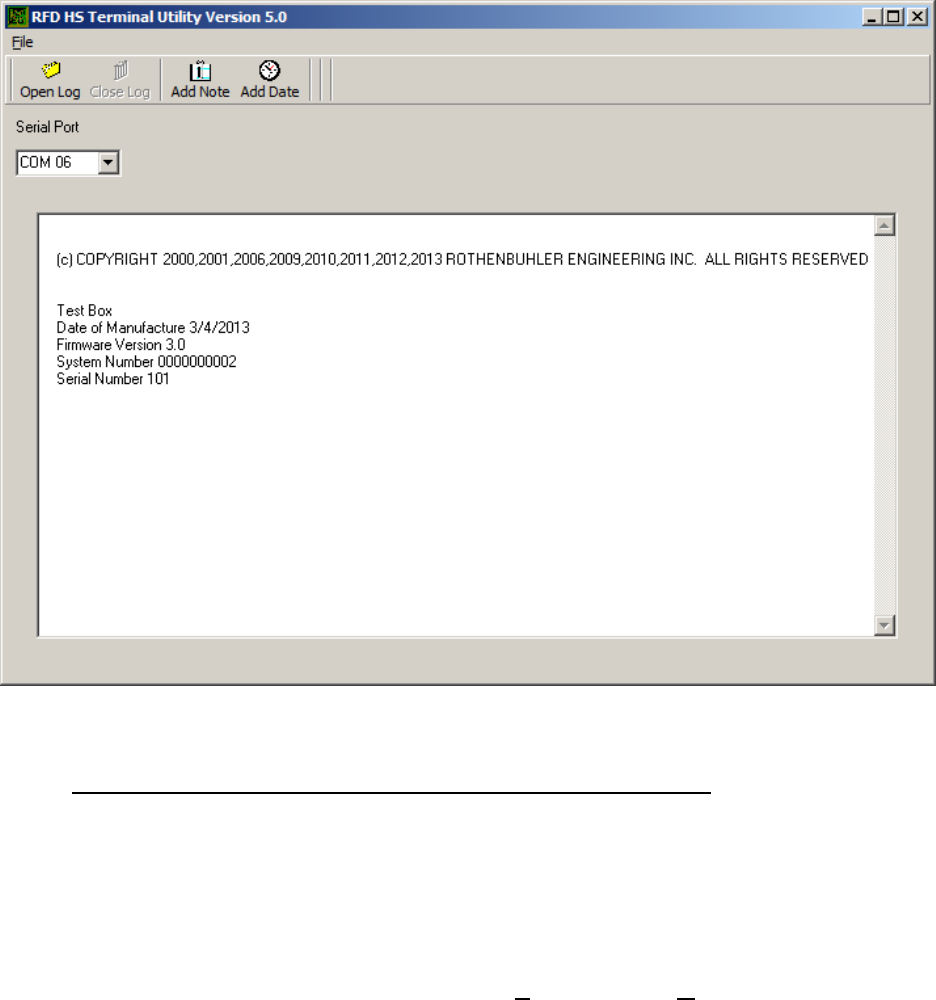
1678 RFD OPERATION MANUAL 70
15. The information from the Test Box should be displayed in the Terminal window.
9.7. USING RFD HS TERMINAL UTILITY TO TEST RFD UNITS
The RFD HS Terminal Utility program may be used with the 1678-4-V2 Test Boxes for
recording test results. It is also compatible with 1678-4 Test Boxes with a firmware
version of 3.0 or greater.
Creating a Test Results Log File:
• If a log file of test results is desired, click “File” and then “Open Log File…”. The
following dialog box will appear.
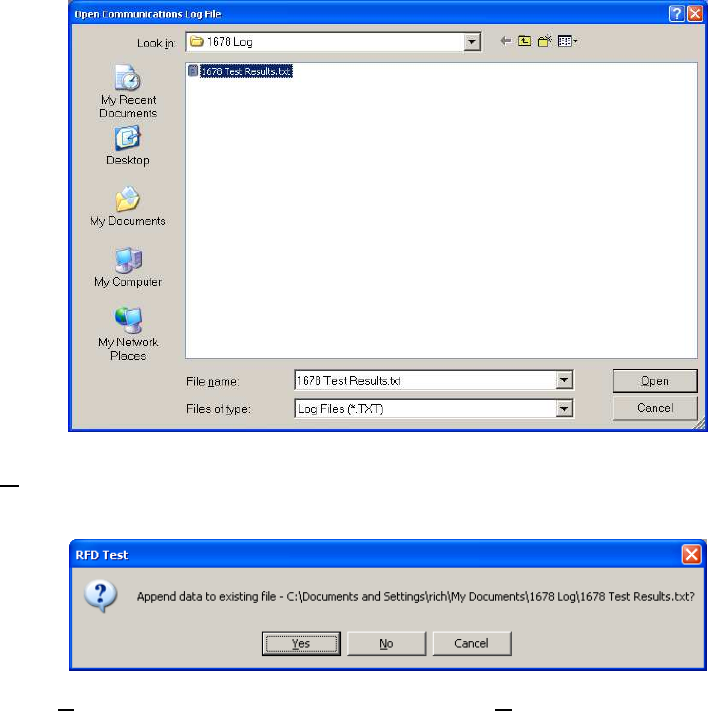
1678 RFD OPERATION MANUAL 71
• Type in a file name for the log file or select an existing file to use. Click the
“Open” button.
• If the file already exists, the following prompt appears.
• Click “Yes” to append (add to) existing data or “No” to overwrite the existing file.
• A time and date stamp is added to the window.
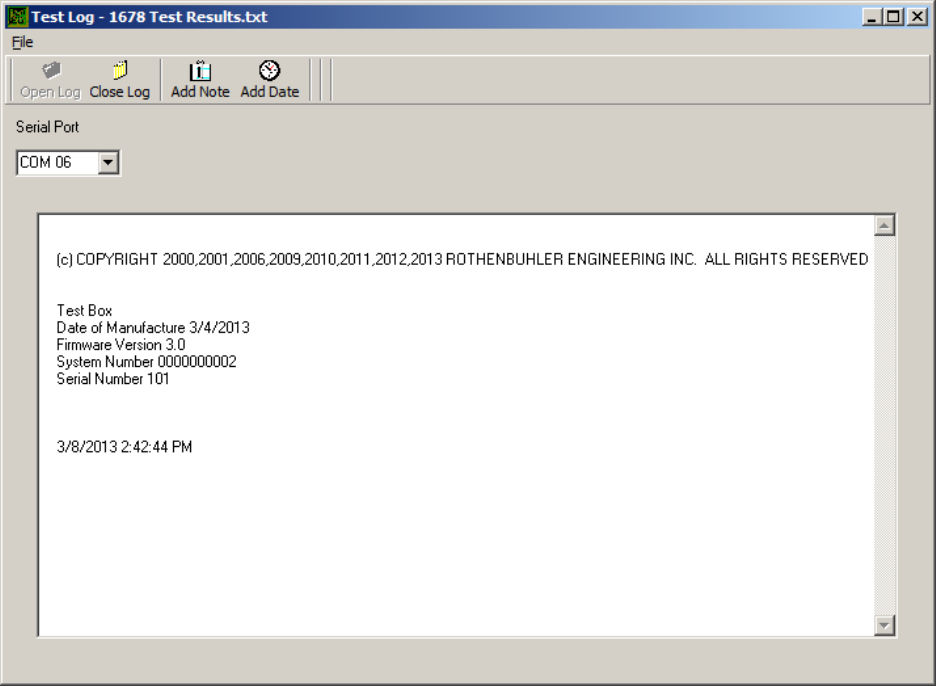
1678 RFD OPERATION MANUAL 72
• Notes can be added to the log file by clicking the note card icon and typing the
note in the dialog box that appears. Multiple notes can be added as required.
• Connect the Test Box Probe to an Electric Remote Unit, RSTI, or Controller.
• If testing the Controller, place the unit in Program mode by turning the unit on
while holding the select switch for #3.
• The Test Box reads and displays the system information from the unit connected
both on the LCD display of the Test Box, and on the RFD HS Terminal Utility
window. The Electric Remote and RSTI will begin reading and displaying unit
parameters automatically and then will conduct an ARM/FIRE test. The
Controller displays unit parameters. All units then execute a loaded battery test
voltage test. The results are displayed as shown in the next window.
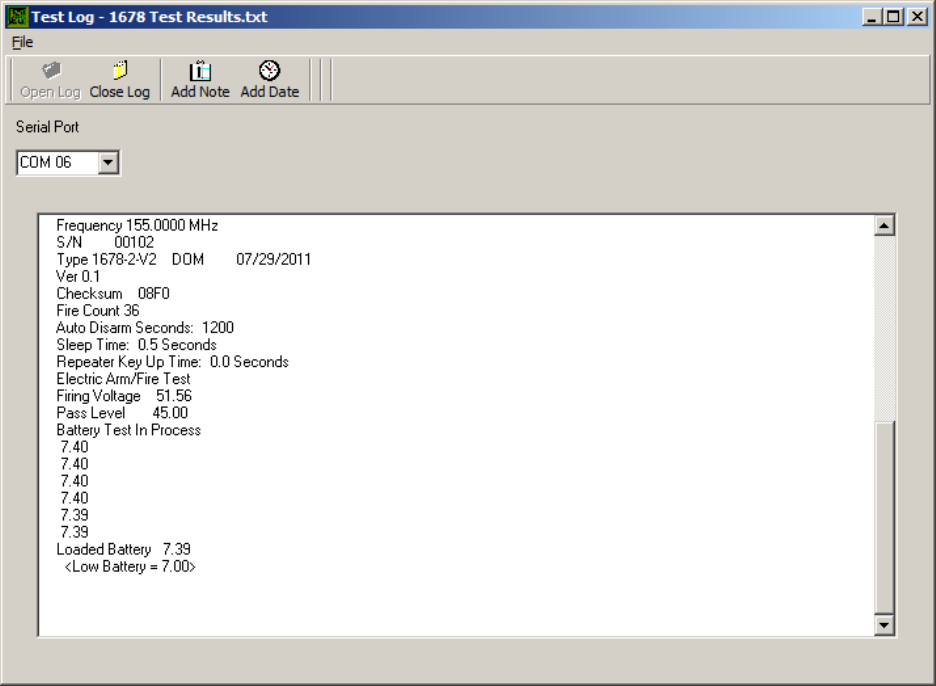
1678 RFD OPERATION MANUAL 73
• Changes to unit parameters and settings are not permitted with RFD HS
Terminal Utility. Advanced user software is available which allows some system
parameter changes to be made. Advanced user software permits changes to the
Unit ID# and System number assignments of the Electric Remote & RSTIs as
well as sleep mode settings and repeater delays. Please contact the factory to
discuss your application if you feel that advanced user software may be required.

1678 RFD OPERATION MANUAL 74
10. MAINTENANCE
The units will provide optimum performance and maximum life when the following
recommendations are adhered to.
10.1. SCHEDULED SERVICING
It is recommended that you return your RFD System to the manufacturer or an
authorized service shop every 2-3 years for service. During servicing, each unit is
evaluated and adjusted to maintain optimal performance. The hardware of the unit is
checked and replaced as needed. Additionally, general updates and service bulletins
are included with no additional cost. It is also recommended that the battery packs be
replaced at this time.
10.2. BATTERY CHARGING INFORMATION
10.2.1. Battery Temperature
For maximum efficiency, charge the batteries when they are at temperatures between
50˚F and 86˚F (10˚C and 30˚C). DO NOT attempt to charge batteries that are below
32˚F (0˚C) or above 104˚F (40˚C). Permanent damage to batteries and or equipment
may result.
10.2.2. Pre-operation
Use the Battery Charger Assembly to discharge and then charge the battery of each
unit.
10.2.3. Periodic
3 Position Charger: For optimal battery health, perform two or more full charge cycles
per month on each unit. Allow the units to discharge to a low battery level before
recharging.
5 Position Charger Conditioner: For optimal battery health, use the Discharge &
Charge Mode when recharging is required. Condition the battery every 6 months
using the Condition (Restore) Mode.
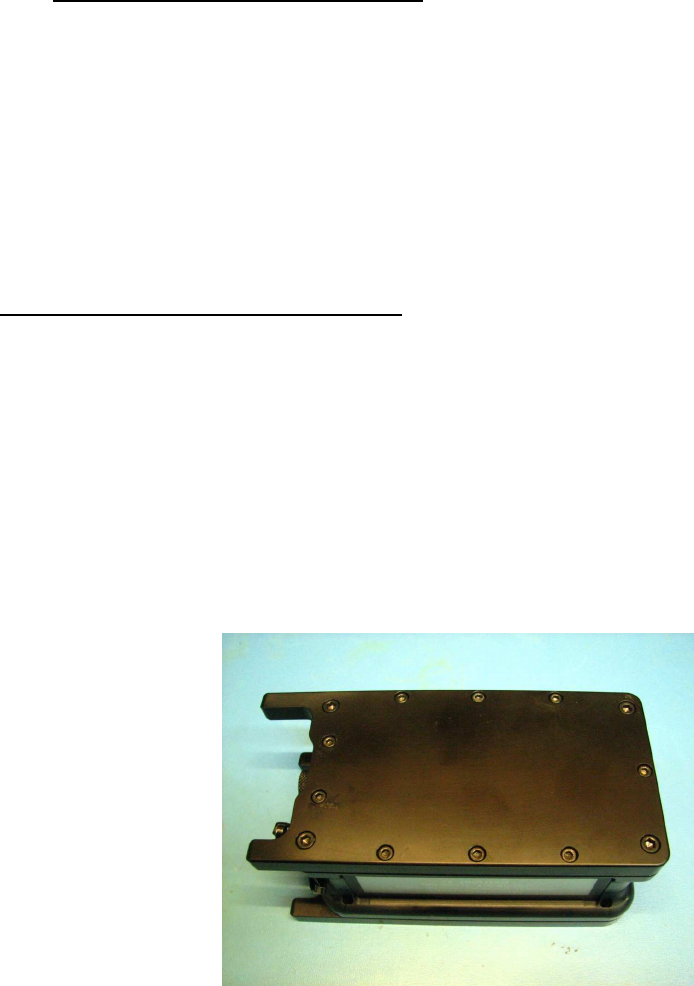
1678 RFD OPERATION MANUAL 75
10.3. BATTERY PACK REPLACEMENT
It is recommended that the battery packs contained in each unit should be replaced
every 300 charge / discharge cycles. This number can be read and displayed with the
optional RFD Test Box. If a Test Box is not available, this number can be estimated
by your typical usage. It is recommended that the battery pack is replaced by the
factory so that the case seals can be fully tested prior to re-deployment. For this
reason, it may be desirable to arrange battery pack replacement with Scheduled
Service of the RFD system. To ensure quality and safety, only OEM battery packs
can be used in the RFD units.
Battery Pack Replacement Procedure
10.3.1. Battery pack placement may be performed by the user under certain
conditions. Battery packs replacement should only be performed indoors in a dry,
clean, dust-free work environment. Replacement should only be performed by
persons having sufficient skills and tools to perform the work described below. The
use of non OEM battery packs is not allowed.
1. Loosen and remove the 9 or 13 smaller machine screws on the backside of the
unit using a 7/64 Allen wrench. Then loosen and remove the four larger machine
screws using a 9/64 Allen wrench.
2. Separate the lid from the main body exposing the battery.
3. A black plastic connector housing at the bottom of the case attaches to the 3-wire
battery connector plug. Carefully cut the white nylon cable tie from the clip on the
battery pack and remove.
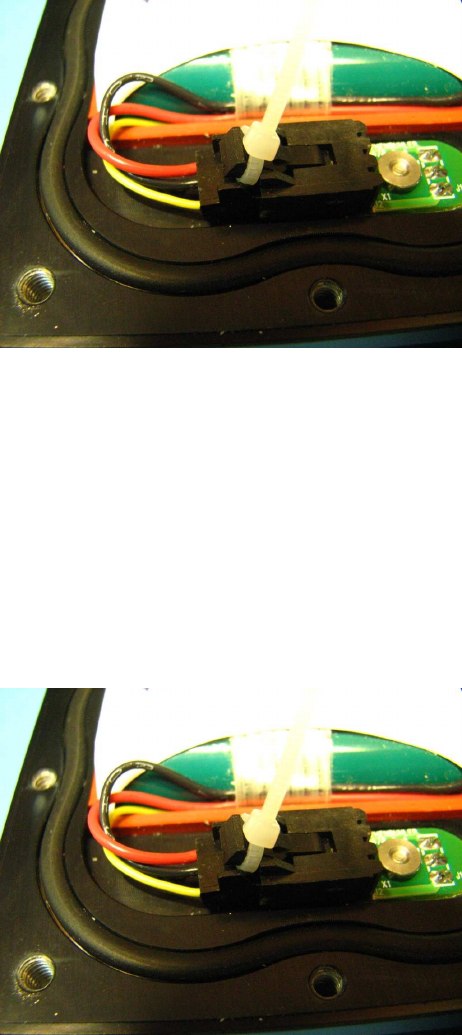
1678 RFD OPERATION MANUAL 76
4. Push the tab on the 3-wire battery connector plug and gently pull to release it from
the receptacle.
5. Gently pry the battery pack from the main body.
6. Replace battery pack with the new pack. Carefully route the wires to the inside of
the seal wall to prevent pinching when the case is closed. Snap the battery pack’s
3-wire plug into the connector housing. Install the cable tie as shown to ensure the
battery pack does not detach under mechanical stress. Trim the excess portion of
the cable tie.
7. Replace the seal using the new seal supplied in the kit. Ensure the seal groove
and the battery lid’s sealing surfaces are clean and dry. The seam in the seal
should be oriented toward the straight part of the case at the top.
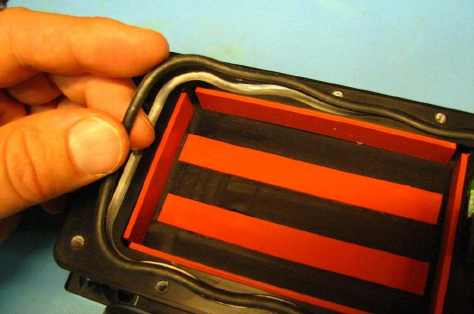
1678 RFD OPERATION MANUAL 77
8. Restore the lid and screws. Tighten screws in a criss-cross pattern. Torque all
screws to 10 inch-lbs.
9. Charge the battery before use. If the 5 Position Charger Conditioner is available,
perform a Condition (Restore) operation to maximize the batteries useable
capacity.
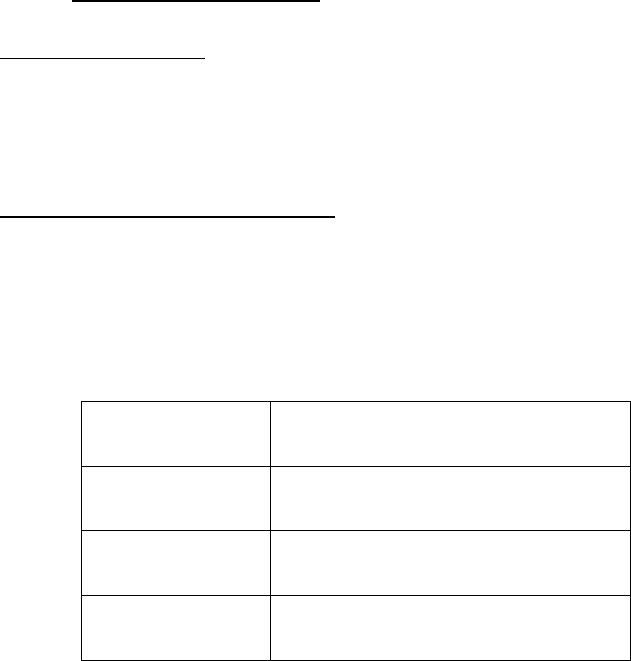
1678 RFD OPERATION MANUAL 78
10.4. EXTENDED NON-USE
3 Position Charger: For optimal storage life, store units with their batteries discharged to
a low battery. Several full charge/discharge cycles may be necessary before the
battery’s capacity is restored to full. Units should be stored without the antennas
attached.
5 Position Charger Conditioner: For optimal battery health, use the Discharge (Store)
function to discharge the battery before storage. Use the Condition (Restore) function
prior to use. Units should be stored without the antennas attached.
Do not exceed the storage temperature guidelines below. Storage outside of this range
may reduce battery capacity and/or cause physical deterioration of battery components.
Storage Time Storage Temperature
<30 days -4 to 122°F (-20 to +50°C)
30 - 90 days -4 to 104°F (-20 to +40°C)
>90 days -4 to 86 °F (-20 to +30°C)
1678 RFD OPERATION MANUAL 79
Revision History:
Rev A, January 31, 2012: Added instruction to install and use the virtual USB Software.
Rev B, March, 5, 2012: Updated Figure 2-1 and Figure 2-13 to show the new case foam
and decals.
Rev C, March 8, 2013: Added 1678-1-V2 Controller Unit. Made references to
Controllers be more generic where possible. Updated Test Box photo and Windows
RFD Terminal Utility screen captures.